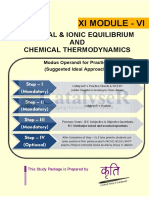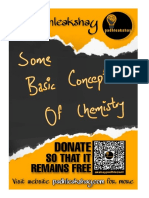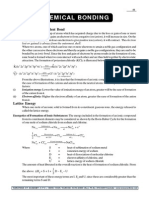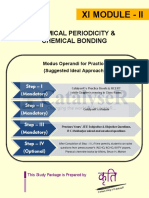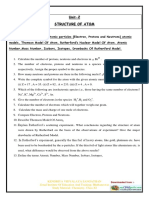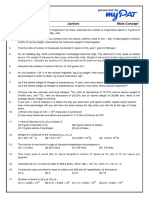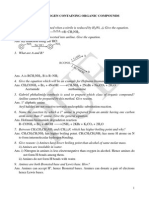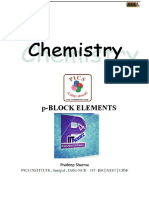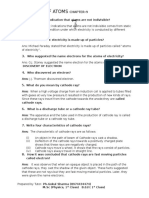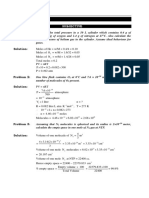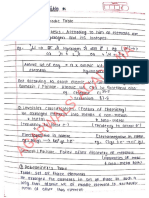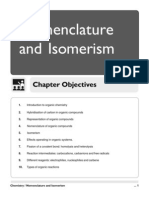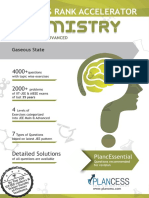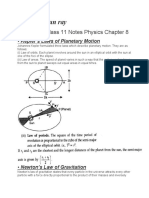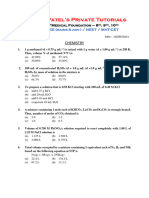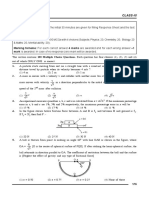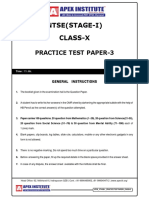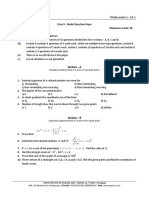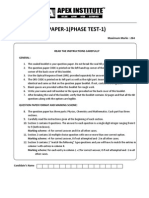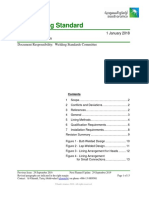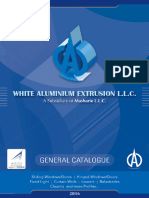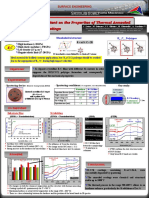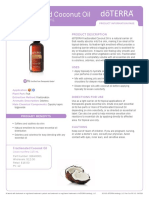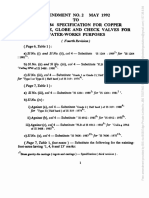Mole Concept
Mole Concept
Uploaded by
Apex InstituteCopyright:
Available Formats
Mole Concept
Mole Concept
Uploaded by
Apex InstituteOriginal Title
Copyright
Available Formats
Share this document
Did you find this document useful?
Is this content inappropriate?
Copyright:
Available Formats
Mole Concept
Mole Concept
Uploaded by
Apex InstituteCopyright:
Available Formats
54
MOLE CONCEPT
Q.1
1 gram molecule of chlorine combines with a certain weight of a metal giving 111 g of its chloride. The same weight of the metal displaced 2 g of hydrogen from an acid. The atomic weight of the metal (assuming its valency to be 2) is : (A) 40 (B) 20 (C) 80 (D) none of these A solution of KMnO4 is reduced to MnO2. The normality of solution is 0.6 N. The molarity is (A) 1.8 M (B) 0.6 M (C) 0.2 M (D) 0.1 M 9 gm of Al (at. Wt. = 27) will react completely with an acid to give : (B) one half mole of H2 (A) one mole of H2 (C) one-third mole of H2 (D) none of these Number of moles of electrons taken up when 1 mole of NO3 ions is reduced to 1 mole of NH2OH is : (A) 2 (B) 4 (C) 5 (D) 6 What volume of chlorine at STP is required to liberate all the iodine from 200 ml of 0.2 M KI solution : (A) 896 ml (B) 448 ml (C) 224 ml (D) 672 ml 5 ml of N HCl, 20 ml N/2 H2SO4 and 30 ml of N/3 HNO3 are mixed together and volume made to 1 litre. The normality of resulting solution is : (A) N/5 (B) N/10 (C) N/20 (D) N/40 Equivalent mass of Na2S2O3 in its reaction with I2 is equal to : (A) molar mass (B) molar mass/2 (C) molar mass/3 (D) molar mass/4
Q.2 Q.3
Q.4
Q.5
Q.6
Q.7 Q.8
A certain compound has the molecular formula X4O6. If 10 gm of compound contains 5.62 g of X, the atomic mass of X : (A) 32 amu (B) 37 amu (C) 42 amu (D) 48 amu The no. of mol. of the independent species present in one mole of potash alum (A) 32 (B)16 (C) 38 (D) 64
Q.9
Q.10 How many gram of H3PO4 would be needed to neutralise 100 gm of Mg (OH)2 ? (A) 66.7 gm (B) 252 gm (C) 112.6 gm (D) 168 gm Q.11 Hardness of water sample is 300 ppm CaCO3. Hence its molarity is : (A) 0.3 M (B) 0.030 M (C) 0.003 M (D) 0.0015 M
Q.12 What weight of CuSO4.5H2O must be taken to make 0.5 litre of 0.01 M Cu2+ ions solution ? (A) 12.45 gm (B) 1.245 gm (C) 6.24 gm (D) 100 gm Q.13 Calculate the volume of CO2 produced by the combustion of 40 ml of acetone vapours in presence of excess of oxygen (A) 12 ml (B) 1.20 ml (C) 120 ml (D) 11.2 ml
APEX INSTITUTE - 62, Nitikhand-III, Indirapuram, Ghaziabad Ph.No.-+91-9910817866, 0120-4901457,website : www.apexiit.co.in/
MOLE CONCEPT
55
Q.1
A partially dried clay mineral contains 8% water. The original sample contained 12 % water and 45 % silica. The % of silica in the partially dried sample is nearly : (A) 50 % (B) 49 % (C) 55 % (D) 47 % When one gram mole of KMnO4 reacts with HCl, the volume of chlorine liberated at NTP will be : (A) 11.2 litres (B) 22.4 litres (C) 44.8 litres (D) 56.0 litres 8 g of sulphur is burnt to form SO2 which is oxidised by Cl2 water. The solution is treated with BaCl2 solution. The amount of BaSO4 precipitated is : (A) 1 mole (B) 0.5 mole (C) 0.24 mole (D) 0.25 mole 1 gram of a carbonate of a metal was dissolved in 25 ml of 1N HCl. The resulting liquid required 5 ml of N NaOH for neutralization. The eq. wt. of metal carbonate is : (A) 100 (B) 30 (C) 40 (D) 50 Sulphuryl chloride SO2Cl2 reacts with water to give a mixture of H2SO4 and HCl. How many moles of NaOH would be needed to neutralize the solution formed by adding 1 mole of SO2Cl2 to excess of water . (A) 1 (B) 3 (C) 2 (D) 4 Hydrogen peroxide in aqueous solution decomposes on warming to give oxygen according to the equation 2H2O2(aq.) 2H2O(l) + O2(g) under conditions where one mole of gas occupies 24 dm3, 100 cm3 of XM solution of H2O2 produces 3dm3 of O2. X is thus : (A) 2.5 (B) 1 (C) 0.5 (D) 0.25 In an experiment 50 ml of 0.1 M solution of a salt reacted with 25 ml of 0.1 M solution of sodium sulphite. The half equation for the oxidation of sulphite ion is SO32 (aq.) + H2O(l) SO42 (aq.) + 2H+ (aq.) + 2e If the oxidation number of metal in the salt was 3, what would be the new oxidation number of metal ? (A) 0 (B) 1 (C) 2 (D) 4 One mole of a mixture of CO and CO2 requires exactly 20 gram of NaOH in solution for complete conversion of all the CO2 into Na2CO3. How many grams more of NaOH would it require for conversion into Na2CO3 if the mixture (one mole) is completely oxidized to CO2 . (A) 60 grams (B) 80 grams (C) 40 grams (D) 20 grams When BrO3 ion reacts with Br ion in acid solution Br2 is liberated the equivalent weight of KBrO3 in this reaction is : (A) M/8 (B) M/3 (C) M/5 (D) M/6 [ where M is the molar mass ]
Q.2
Q.3
Q.4
Q.5
Q.6
Q.7
Q.8
Q.9
Q.10 A solution contains both Na2CO3 and NaHCO3 was treated with excess of CaCl2 solution and filtered. The precipitate weighed m1 grams. On adding NaOH in drops to the filtrate avoiding excess, a further m2 grams was precipitated. If after adding excess CaCl2, the solution (had not been filtered) but was simply boiled and then filtered, what would be the total weight of the precipitate ? (A) (m1 + m2) grams (B) (m1 + m2/2) grams (C) (m1 + m2) /2 grams (D) (m2+m1/2) grams
APEX INSTITUTE - 62, Nitikhand-III, Indirapuram, Ghaziabad Ph.No.-+91-9910817866, 0120-4901457,website : www.apexiit.co.in/
56
MOLE CONCEPT
Q.11 2 grams of a gas mixture of CO and CO2 on reaction with excess I2O5 yield 2.54 grams of I2. 7What would be the weight % of CO in the original mixture ? (A) 70.1 (B) 75.3 (C) 68.4 (D) 80.7 Q.12 One gram of a mixture of Na2CO3 and NaHCO3 consumes y gram equivalents of HCl for complete neutralisation. One gram of the mixture is strongly heated, then cooled and the residue treated with HCl. How many gram equivalents of HCl would be required for complete neutralisation : (A) 2y gram equivalent (B) y gram equivalents (C) 3y/4 gram equivalents (D) 3y/2 gram equivalents Q.13 In an organic compound of molar mass greater than 100 containing only C, H and N, the percentage of C is 6 times the percentage of H while the sum of the percentages of C and H is 1.5 times the percentage of N. What is the least molar mass : (A) 175 (B) 140 (C) 105 (D) 210 Q.14 One gram of a variable alloy of lead and tin yielded on treatment with conc. HNO3, filtration and heating 0.42 grams of SnO2. If all the lead in one gram of alloy is converted into PbSO4, what will be the weight of PbSO4 obtained ? (A) 0.98 (B) 1 g (C) 1.07 g (D) 0.95 g Q.15 An iodide solution, litre containing 0.664 grams of KI per litre, required 100 ml of a certain solution of Ce4+ ion for complete reaction. What is the normality of the Ce4+ solution ? (A) 0.04 (B) 0.004 (C) 0.02 (D) none of these Q.16 A solution contains Na2CO3 and NaHCO3. 10 ml of the solution required 2.5 ml of 0.1 M H2SO4 for neutralisation using phenolphthalein as indicator. Methyl orange is then added when a further 2.5 ml of 0.2 M H2SO4 was required. The amount of Na2CO3 and NaHCO3 in 1 litre of the solution is : (A) 5.3 g & 4.2 g (B) 3.3 g & 6.2 g (C) 4.2 g & 5.3 g (D) 6.2 g & 3.3 g Q.17 0.7 g of a sample of Na2CO3. x H2O were dissolved in water and the volume was made to 100 ml . 20 ml of this solution required 19.8 ml of N/10 HCl for complete neutralization. The value of x is : (A) 7 (B) 3 (C) 2 (D) 5 Q.18 34 g of hydrogen peroxide is present in 1120 ml of solution. This solution is called : (A) 10 vol solution (B) 20 vol solution (C) 30 vol solution (D) 32 vol solution Q.19 Exactly 4.00 gm of a solution of H2SO4 was diluted with water and excess BaCl2 was added. The washed and dried precipitate of BaSO4 weighed 4.08 gm. Find the percent H2SO4 in the original acid solution. (A) 43.0 % (B) 4.3 % (C) 47 % (D) none Q.20 What volume of 96 % H2SO4 by weight solution (density 1.83 g/ml) is required to prepare 2.00 L of 3.00 M H2SO4 solution ? (A) 335 ml (B) 670 ml (C) 167.5 ml (D) none
APEX INSTITUTE - 62, Nitikhand-III, Indirapuram, Ghaziabad Ph.No.-+91-9910817866, 0120-4901457,website : www.apexiit.co.in/
MOLE CONCEPT
57
Q.1
10.78 g of H3PO4 in 550 ml solution is 0.40 N. Thus this acid : (A) has been neutralised to HPO42 (B) has been neutralized to PO42 2 (C) has been reduced to HPO3 (D) has been neutralised to H2PO4 0.1 mol of MnO4 (in acidic medium) can : (A) oxidise 0.5 mol of Fe2+ (C) oxidise 0.25 mol of C2O42 (B) oxidise 0.166 mol of FeC2O4 (D) oxidise 0.6 mol of Cr2O72 (D) normality
Q.2
Q.3 Q.4
Which of the following quantities are independent of temperature (A) Molarity (B) mole fraction (C) molality 1 mol BaF2 + 2mol H2S4 (A) 1 mol of KOH (C) 4 mol KOH
resulting mixture will be neutralised by : (B) 2 mol of Ca(OH)2 (D) 2 mol of KOH
Q.5
Which of the following represent redox reactions : (A) Cr2O72 + 2OH 2CrO42 + H2O Cr2O72 + H2O (B) 2CrO42 + 2H+ (C) 2MnO4 + 3Mn2+ + 4OH 5 MnO2 + 2H2O Cu + Cu2+ (D) 2Cu+ When (NH4)2 Cr2O7 is heated : (A) there is oxidation of N (C) net reaction is disproportionations (A) 2RCHO Al( OEt )3 RCOOCH2R N2O + 2H2O (C) NH4NO3
Q.6
(B) there is reduction of Cr (D) net reaction is neutralisation (B) 4H3PO3 3H3 PO4 + PH3 (D) PCl5 PCl3 + Cl2 CaHPO4 + 2H2O
Q.7
Which of the following are disproportionation reaction ?
Q.8
For the reaction :
H3PO4 + Ca(OH)2
1 mol 1 mol
Which are true statements : (A) equivalent weight of H3PO4 is 49 (B) resulting mixture is neutralised by 1 mol of KOH (C) CaHPO4 is an acid salt (D) 1 mol of H3PO4 is completely neutralised by 1.5 mol of Ca(OH)2. Q.9 3H3PO2 PH3 + 2H3PO3 . In this reaction : (A) H3PO2 undergoes disproportionation (B) equivalent weight of H3PO2 is 22 (C) equivalent weight of H3PO2 is 49.5 (D) NaH2PO2 is not acid salt.
Q.10 11.2 g of mixture of MCl (volatile) and NaCl gave 28.7 g of white ppt with excess of AgNO3 solution. 11.2 g of same mixture on heating gave a gas that on passing into AgNO3 solution gave 14.35 g of white ppt. Hence: (A) ionic mass of M+ is 18 (B) mixture has equal mole fraction of MCl and NaCl (C) MCl and NaCl are in 1 : 2 molar ratio (D) ionic mass of M+ is 10
APEX INSTITUTE - 62, Nitikhand-III, Indirapuram, Ghaziabad Ph.No.-+91-9910817866, 0120-4901457,website : www.apexiit.co.in/
58
MOLE CONCEPT
Q.11 H2C2O4 and NaHC2O4 behave as acids as well as reducing agents. which are correct statement? (A) equivalent weight of H2C2O4 and NaHC2O4 are equal to their molecular weights when behaving as reducing agents (B) 100 ml of 1 N solution of each is neutralised by equal volume of 1M Ca(OH)2 (C) 100 ml of 1 N solution of each is neutralised by equal volume of 1N Ca(OH)2 (D) 100 ml of 1 M solution of each is oxidised by equal volumes of 1M KMnO4 Q.12 Which of the following are primary standard substances ? (A) Na2CO3.10H2O (B) NaOH (D) KMnO4 (C) Na2B4O7.10H2O Q.13 Which of the following statements are correct ? (A) the point at which an equivalent amount of the titrant is added is called the equivalence point. (B) the point at which the reaction is observed to be complete is called the end point (C) at the end point of a reaction there is no change in the properties of the solution (D) at the equivalence point of a reaction the stoichiometric amount of the titrant is not added Q.14 100 mL of a 0.1 M SO42- solution is : (A) 10 millimoles (C) 20 milliequivalents (B) 5 millimoles (D) 40 milliequivalent
Q.15 Which of following will be present in the solution formed when 50 mL of 0.1 M HCl is mixed with 50 mL of 0.1 M NaOH ? (B) 0.05 m mol of OH(A) 4.5 m mol of H+ (C) 0.05 M NaCl (D) 10-7 M of H+ ion Q.16 Which of the following statements are correct ? (A) during the titration of a strong acid against a strong base, the pH at the at the equivalence point will be neutral (B) during the titration of a weak acid against a strong base, the pH at the at the equivalence point will be alkaline (C) during the titration of a weak acid against a strong base, the pH at the at the equivalence point will be acidic (D) during the titration of a weak acid against a weak base, the pH at the at the equivalence point will be neutral Q.17 During the titration of a mixture of Na2CO3 and NaHCO3 against HCl, (A) phenolphthalein is used to detect the first end point (B) phenolphthalein is used to detect the second end point (C) methyl orange is used to detect the second end point (D) methyl red is used to detect the first end point Q.18 1 mol of H2SO4 will exactly neutralize (A) 2 mol of ammonia (C) 0.5 mol of Ba(OH)2 (B) 1 mol of Ba(OH)2 (D) 2 mol of KOH
Q.19 At the end point there is a sharp change of colour in the indicator. This happens because the (A) pH at the end point changes sharply (B) structure of the indicator changes (C) colour of indicator is adsorbed by water (D) dissociation constants of acids and bases differ by ten
APEX INSTITUTE - 62, Nitikhand-III, Indirapuram, Ghaziabad Ph.No.-+91-9910817866, 0120-4901457,website : www.apexiit.co.in/
MOLE CONCEPT
59
Q.20 20 volumes of H2O2 is equal to : (A) 20% H2O2 by mass (C) 1.764 N
(B) 6% H2O2 by mass (D) 3.528 N
Q.21 A solution of Na2S2O3 is standardized iodometrically against 0.1262 g of KBrO3. This process requires 0.45 mL of Na2S2O3 solution. What is the strength of the Na2S2O3 ? (A) 0.2 M (B) 0.1 M (C) 0.05 N (D) 0.1 N Q.22 Which of the following expressions is correct ( n = no. of moles of the gas, NA = Avogadro constant, m = mass of molecule of the gas, N= no. of molecules of the gas) (B) m = nNA (C) N = nNA (D) m = mn/NA (A) n = mNA Q.23 In which of the following pairs do 1g of each have an equal number of molecules? (B) N2 and C3O2 (C) N2 and CO (D) N2O and CO2 (A) N2O and CO Q.24 Among the following, which solutions contain equal numbers of millimoles ? (A) 100 mL of 0.05 M H2SO4 (B) 200 mL of 0.0 M NaOH (D) 200 mL of 0.025 MKOH (C) 100 mL of 0.10 M Na2C2O4 Q.25 1 mol of 14 N 3 ions contains 7 (A) 4NA electrons (B) 7NA protons (C) 7NA neutrons (D) 14NA protons (D) CO (D) [Cr(OH)4] (D) C12H22O11 Q.26 11.2 L of gas at stp weighs 14.0 g. The gas could be : (A) N2O (B) NO2 (C) N2 Q.27 The oxidation number of Cr = + 6 in : (B) KCrO3Cl (A) FeCr2O4 Q.28 The oxidation number of carbon is zero in : (A) HCHO (B) CH2Cl2 (C) CrO5 (C) C6H12O6
Q.29 Which of the following are not redox reactions ? (A) Mg + N2 Mg3N2 (B) K4[Fe(CN)6] + H2SO4 + H2O K2SO4 + CO + FeSO4 + (NH4)2SO4 (C) I2 + 3Cl2 ICl3 (D) CuSO4 + NH3 [Cu(NH3)4]SO4 Q.30 Which of the following are redox reactions ? (A) NaIO3 + NaHSO3 NaHSO4 + Na2SO4 + I2 + H2O (B) FeCl3 + K4[Fe(CN)6] KCl + Fe4[Fe(CN)6]3 (C) AgCl + Na2S2O3 Na3[Ag(S2O3)2] + NaCl (D) NaBiO3 + MnSO4 + HNO3 HMnO4 + Bi(NO3)3 + NaNO3 + Na2SO4 + H2O Q.31 Which among the following are examples of autoredox reactions? (A) P4 + OH H2PO4 + PH3 (B) S2O32 SO42 + S (C) H2O2 H2O + O2 (D) AgCl + NH3 [Ag(NH3)2]Cl Q.32 The oxidation number of S= +6 in (A) peroxomonosulphuric acid (Caros acid) (B) peroxodisulphuric acid (Marshalls acid) (C) pyrosulphuric acid (oleum) (D) sodium thio sulphate (hypo) Q.33 Which of the following have been arranged in order of decreasing oxidation number of sulphur? (A) H2S2O7 > Na2S4O6 > Na2S2O3 > S8 (B) SO2+ > SO42 > SO32 > HSO4 (C) H2SO5 > S2SO3 > SCl2 > H2S (D) H2SO4 > SO2 > H2S > H2S2O8
APEX INSTITUTE - 62, Nitikhand-III, Indirapuram, Ghaziabad Ph.No.-+91-9910817866, 0120-4901457,website : www.apexiit.co.in/
60
MOLE CONCEPT
Q.34 Calculate the amount of lime (CaO) produced by heating 100 g of 90% pure limestone. (A) 50.4 g (B) 0.98 mol (C) 0.90 mol (D) 56.0 g Q.35 2 mol of CO2 is required to prepare (A) 336 of NaHCO3 (C) 463 g of Ca(HCO3)2 (B) 168 g of NaHCO3 (D) 162 g of Ca(HCO3)2
Q.36 1.5 g of oxygen is produced by heating KClO3. How much KCl is produced in the reaction? (A) 4.15 x 102 mol (B) 4.33 g (C) 1.78 x 102 mol (D) 1.33 g Q.37 Which of the following gases are absorbed by an ammoniacal cuprous chloride solutions ? (D) C2H2 (A) NO (B) CO (C) O3 Q.38 50 milliliters of CO is mixed with 20 mL of oxygen and sparked. After the reaction, the mixture is treated with an aqueous KOH solution. Choose the correct option. (A) The volume of the CO that reacts = 40 mL (B) The volume of the CO2 formed = 40 mL. (C) The volume of the CO that remains after treatment with KOH = 10 mL (D) The volume of the CO that remains after treatment with KOH = 20 mL
APEX INSTITUTE - 62, Nitikhand-III, Indirapuram, Ghaziabad Ph.No.-+91-9910817866, 0120-4901457,website : www.apexiit.co.in/
MOLE CONCEPT
61
Q.1
If volume strength of H2O2 solution is X-V then its Column I Column II X (a) Strength in g/L (i) 11.2 (b) (c) Volume strength X Molarity (ii) (iii) X 5.6
(d) Normality (A) (a) - (iii) , (b) - (i) , (c) - (iv) , (d) - (ii) (C) (a) - (iii) , (b) - (iv) , (c) - (i) , (d) - (ii) Q.2 (a) (b) (c) (d) (e) (A) (B) (C) (D) Q.3 (a) (b) (c) (d) (e) (A) (B) (C) (D) Q.4 Column I Reactant H3PO 3 H3PO 4 3MnO4 2Mn2+ + Mn+6 FeC2O4 Fe3+ + 2CO2 2H2O2 O2 + 2H2O
17 X 5.6 (iv) 5.6 N (B) (a) - (iv) , (b) - (i) , (c) - (ii) , (d) - (i) (D) (a) - (iii) , (b) - (ii) , (c) - (iv) , (d) - (i)
Column II n-factor (i) 11/3 (ii) 2 (iii) 3
(a) - (ii) , (b) - (iii) , (c) - (i) , (d) - (iii), (e)-(ii) (a) - (i) , (b) - (ii) , (c) - (iii) , (d) - (ii), (e)-(i) (a) - (ii) , (b) - (i) , (c) - (ii) , (d) - (iii), (e)-(ii) (a) - (iii) , (b) - (ii) , (c) - (i) , (d) - (ii), (e)-(iii) Column I HClO4 H2S Na 2 S 2O 7 SO 2 HNO 2 (i) (ii) (iii) Column II Oxidising agent Reducing agent Oxidising as well as reducing agent
(a) - (ii) , (b) - (iii) , (c) - (i) , (d) - (iii), (e)-(ii) (a) - (i) , (b) - (ii) , (c) - (iii) , (d) - (ii), (e)-(i) (a) - (ii) , (b) - (i) , (c) - (ii) , (d) - (iii), (e)-(ii) (a) - (i) , (b) - (ii) , (c) - (ii) , (d) - (iii), (e)-(iii)
When mixture of 0.1 equivalent of each of the reactants mentioned under column I are reacted with 1 M HCl solution. in presence of indicator phenolphthalein, the volume required in ml of HCl solution for complete neutralization will be: Column I Column II (a) Na2CO3 + NaHCO3 (i) 100 ml (b) NaOH + NaHCO3 (ii) 150 ml (c) Na2CO3 + Na2CO3 (iii) 50 ml (d) Na2CO3 + NaHCO3 + NaOH (A) (a) - (i) , (b) - (iii) , (c) - (i) , (d) - (ii) (C) (a) - (ii) , (b) - (i) , (c) - (ii) , (d) - (iii) (B) (a) - (i) , (b) - (ii) , (c) - (iii) , (d) - (ii) (D) (a) - (iii) , (b) - (i) , (c) - (ii) , (d) - (ii)
APEX INSTITUTE - 62, Nitikhand-III, Indirapuram, Ghaziabad Ph.No.-+91-9910817866, 0120-4901457,website : www.apexiit.co.in/
62
MOLE CONCEPT
Q.5 (a) (b) (c) (d)
Column I MR on mixing two acidic solutions MR on mixing two basic solutions MR on mixing acidic and basic solutions milliequivalent (i) (ii) (iii) (iv)
Column II
x d 10 M solute
n M V ml
M1V1 M 2 V2 V1 + V2 M1V1 V2 M1V1 + M 2 V2 V1 + V2
(e) (A) (B) (C) (D)
Molarity
(v)
(a) - (i) , (b) - (iii) , (c) - (i) , (d) - (ii), (e)-(iv) (a) - (v) , (b) - (v) , (c) - (iii) , (d) - (ii), (e)-(i, iv) (a) - (ii) , (b) - (i) , (c) - (ii) , (d) - (iii), (e)-(ii) (a) - (i) , (b) - (ii) , (c) - (ii) , (d) - (iii), (e)-(iii)
APEX INSTITUTE - 62, Nitikhand-III, Indirapuram, Ghaziabad Ph.No.-+91-9910817866, 0120-4901457,website : www.apexiit.co.in/
MOLE CONCEPT
63
Q.1 Q.2
Find the number of mole of chloride ion needed to react with sufficient silver nitrate to make 10.0 g of AgCl. What mass of CaCl2 is required to provide this number of mole of Cl ? How many kg of pure H2SO4 could be obtained from 2.00 kg of pure iron pyrites (FeS2) according to the following reactions ? 2SO2 + O2 2SO3 , SO3 + H2O H2SO4 4FeS2 + 11O2 2Fe2O3 + 8SO2 , A solution contains 0.18 g/ml of a substance, X, whose molecular weight is approximately 68000. It is found that 0.27 ml of oxygen at 760 mm and 30C will combine with the amount of X contained in 1.0 ml of the solution. How many molecules of oxygen will combine with one molecule of X ? 5g sample of brass was dissolved in one litre dil. H2SO4. 20 ml of this solution were mixed with Kl, liberating I2 and Cu+ and the I2 required 20 ml of 0.0327 N hypo solution for complete titration. Calculate the percentage of Cu in the alloy. A compound which contains one atom of X and two atoms of Y for each three atoms of Z is made by mixing 5.00 g of X, 1.15 1023 atoms of Y and 0.03 mole of Z atoms. Given that only 4.40 g of compound results. Calculate the atomic weight of Y if the atomic weights of X and Z are 60 and 80 amu respectively. Calculate the mass of oxalic acid which can be oxidized by 100ml of M MnO4 solution, 10ml of which is capable of oxidizing 50ml of 1N I to I2. The iodide content of a solution was determined by the titration with cerium (IV) sulphate in the presence of HCl, in which I- is converted of ICl. A 250 ml sample of the solution required 20 ml of 0.05 N Ce4+ solution. What is the iodide concentration in the original solution in g/litre. A solution is made by mixing 200 ml of 0.1M FeSO4, 200 ml of 0.1 M KMnO4 and 600 ml of 1M HClO4. A reaction occurs in which Fe2+ is converted to Fe3+ & MnO4 to Mn2+ in acid solution. Calculate the concentration of each ion. How many mole FeCl3 can be prepared by the reaction of 10.0g KMnO4, 1.07 mol FeCl2, and 500 mL of 3.00 M HCl? MnCl2 is the reduction product.
Q.3
Q.4
Q.5
Q.6 Q.7
Q.8
Q.9
Q.10 To 100ml of KMnO4 solution containing 0.632 gm of KMnO4, 200 ml of SnCl2 solution containing 2.371 gm is added in presence of HCl. To the resulting solution excess of HgCl2 is added all at once. How many gms of Hg2Cl2 will be precipitated. Q.11 How many gram KMnO4 should be taken to make up 250 mL of a solution of such concentration that 1mL is equivalent to 5.00 mg iron in FeSO4?
Q.12 Exactly 40 ml of an acidified solution of 0.4 M iron (II) ion is titrated with KMnO4 solution. After addition of 32 ml KMnO4, one additional drop turns the iron solution purple. Calculate the concentration of permanganate solution. Q.13 Potassium acid oxalate K2C2O4.3H2C2O4.4H2O can be oxidized by MnO4- in acid medium. Calculate the volume of 0.1M KMnO4 reacting in acid sol. with one gram of the acid oxalate. Q.14 The reaction Cl2 + S2O32- SO42- + Cl- is to be carried out in basic medium. Starting with 0.15 mol of Cl2, 0.01 mol S2O32- and 0.3 mol of OH-, how many moles of OH- will be left in solution after the reaction is complete. Assume no other reaction occurs.
APEX INSTITUTE - 62, Nitikhand-III, Indirapuram, Ghaziabad Ph.No.-+91-9910817866, 0120-4901457,website : www.apexiit.co.in/
64
MOLE CONCEPT
Q.15 0.5M KMnO4 solution completely reacts with 0.05M FeC2O4 solution under acidic conditions where the products are Fe3+, CO2 and Mn2+. The volume of FeC2O4 used is 125 ml. What volume of KMnO4 was used.
Q.1
K2Cr2O7 oxidizes HCl to Cl2, which oxidizes K2MnO4. Calculate the weight of KMnO4 formed from one gram of potassium dichromate by reacting it with excess HCl and using the generated chlorine for oxidizing K2MnO4 (Mn = 55; Cr = 52) A mixture of CaCl2 and NaCl weighing 2.385 g was dissolved in water and treated with a solution of sodium oxalate which produces a precipitate of calcium oxalate. The precipitate was filtered from the mixture and then dissolved in HCl to give oxalic acid which when titrated against 0.2M KMnO4 consumed 19.64 mL of the latter. What was percentage by mass of CaCl2 in the original sample? A certain volume of Ferric sulphate solution was reduced by excess of zinc and was then titrated against 0.1N KMnO4 solution. The titre value was 30 ml. The same volume of ferric salt solution was reduced by another metal X and then titrated against 0.1 N KMnO4 and the titre value was 45 ml. What are the oxidation states of metal X . 1.44g pure FeC2O4 was dissolved in dil. HCl and solution diluted to 100 mL. Calculate volume of 0.01 M KMnO4 required to oxidize FeC2O4 solution completely. 0.804 gm of a sample of iron ore was dissolved in acid. Iron was oxidized to +2 state and it required 117.2 ml of 0.112 N KMnO4 solution for titration. Calculate the percentage of Fe and FeO in the ore. KMnO4 oxidises X+n ion to XO3, itself changing to Mn+2 in acid solution. 2.68 103 mole of X+n requires 1.61 103 mole of MnO4 . What is the value of n? Also calculate the atomic mass of X, if the weight of 1 g equivalent of XCln is 56. A sample of Fe2(SO4)3 and FeC2O4 was dissolved in dil. H2SO4. The complete oxidation of reaction mixture required 40 mL of N/16 KMnO4. After the oxidation, the reaction mixture was reduced by Zn and dil. H2SO4. On again oxidation by same KMnO4, 60 mL were required. Calculate the ratio of Meq. of Fe2(SO4)3 and FeC2O4 in mixture. 2.6 g sample of pyrolusite was boiled with 65 mL. of N oxalic acid and excess of dil. H2SO4. The liquid was then filtered and the residue washed. The filtrate and the washing were mixed and made upto 500 mL. 100 mL of this solution required 50 mL of N/10 KMnO4. Calculate % of MnO2 in sample. 0.5 g sample of iron containing mineral mainly in the form of CuFeS2 was reduced suitably to convert all the ferric ions into ferrous ions (Fe+3 Fe+2) and was obtained as solution. In the absence of any interfering radical, the solution required 42 mL of 0.01 M K2Cr2O7 for titration. Calculate % of CuFeS2 in sample.
Q.2
Q.3
Q.4 Q.5
Q.6
Q.7
Q.8
Q.9
Q.10 Mg can reduce NO3 to NH3 in basic solution: NO3 + Mg(s) + H2O Mg(OH)2(s) + OH (aq) + NH3(g) A 25.0 mL sample of NO3 solution was treated with Mg. The NH3(g) was passed into mL of 0.15 N HCl. The excess HCl required 32.10 mL of 0.10 M NaOH for its neutralisation. What was the molarity of NO3 ions in the original sample?
APEX INSTITUTE - 62, Nitikhand-III, Indirapuram, Ghaziabad Ph.No.-+91-9910817866, 0120-4901457,website : www.apexiit.co.in/
MOLE CONCEPT
65
NCERT TEXT BOOK EXERCISE
Q.1 Q.2 Q.3 Q.4 Calculate the molecular mass of the following : (ii) CO2 (iii) CH4 (i) H2O Calculate the mass per cent of different elements present in sodium sulphate (Na2O4) Determine the empirical formula of an oxide of iron which has 69.9% iron and 30.1% dioxygen by mass. Calculate the amount of carbon dioxide that could be produced when (i) 1 mole of carbon is burnt in air (ii) 1 mole of carbon is burnt in 16 g of dioxygen (iii) 2 moles of carbon are burnt in 16 g dioxygen. Calculate the mass of sodium acetate (CH3COONa) required to make 500 mL of 0.375 molar aqueous solution. Molar mass of sodium acetate is 82.0245 g mol1. Calculate the concentration of nitric acid in moles per liter in a sample which has a density. 1.41 g mL1 and the mass per cent of nitric acid in it being 69%. How much copper can be obtained from 100 g of copper sulphate (CuSO4)? Determine the molecular formula of an oxide or iron in which the mass per cent of iron and oxygen are 69.9 and 30.1 respectively. Calculate the atomic mass (average) of chlorine using the following data; % natural abundance Molar mass 35 Cl 75.77 34.9689 37 Cl 24.23 36.9659
Q.5 Q.6 Q.7 Q.8 Q.9
Q.10 In three moles of ethane (C2H6), calculate the following: (i) Number of moles of carbon atoms. (ii) Number of moles of hydrogen atoms (iii) Number of molecules of ethane. Q.11 What is the concentration of sugar (C12H22O11) in mol L1 if its 20 g are dissolved in enough water to make a final volume up to 2L? Q.12 If the density of methanol is 0.793 Kg L1, what is its volume needed for making 2.5 L of its 0.25 M solution? Q.13 Pressure is determined as force per unit area of the surface. The SI unit of pressure, pascal is as shown below ? 1Pa = 1N m1 If mass of air at sea level is 1034 g cm2, calculate the pressure in pascal. Q.14 What is the SI unit of mass? How is it defined ? Q.15 A sample of drinking water was found to be severely contaminated with chloroform, CHCl3, supposed to be carcinogenic in nature. The level of contamination was 15 ppm(by mass) (i) express this in percent by mass (ii) determine the molality of chloroform in the water.
APEX INSTITUTE - 62, Nitikhand-III, Indirapuram, Ghaziabad Ph.No.-+91-9910817866, 0120-4901457,website : www.apexiit.co.in/
66
MOLE CONCEPT
Q.16 Match the following prefixes with their multiples. Prefixes Multiples (i) micro 10 6 (ii) deca 10 9 (iii) mega 10 6 (iv) giga 10 15 (v) femto 10 Q.17 The following data are obtained when dinitrogen and dioxygen react together to form different compounds. Mass of dinitrogen Mass of dioxygen (i) 14 g 16 g (ii) 14 g 32 g (iii) 28 g 32 g (iv) 28 g 80 g (a) Which law of chemical combination is obeyed by the above experimental data? Give its statements. (b) Fill in the blanks in the following conversions: (i) 1 km = ...................... mm = .......................... pm (ii) 1 mg = .........................kg = .............................ng (iii) 1 mL = ........................ L = ............................. dm3 Q.18 In a reaction A + B2 AB2 Identify the limiting reagent, if any, in the following reaction mixtures. (i) 300 atoms of A + 200 molecules of B (ii) 2 mol A + 3 mol B (iii) 2.5 mol A + 6 mol B Q.19 Dinitrogen and dihydrogen react with each other to produce ammonia according to the following chemical equation : N2(g) + H2(g) 2NH3 (g) (i) Calculate the mass of ammonia produced if 2.00 103 g dinitrogen reacts with 1.00 103 g of dihydrogen. (ii) Will any of the two reactants remain unreacted ? (iii) If yes, which one and what would be tis mass ? Q.20 How are 0.50 mol Na2CO3 and 0.50 M Na2CO3 different ? Q.21 If ten volumes of dihydrogen gas reacts with five volumes of dioxygen gas, how many volumes of water vapour would be produced ? Q.22 Which one of the following will have largest number of atoms ? (i) 1 g Au (s) (ii) 1 g Na (s) (iii) 1 g Li (s) (iv) 1 g of Cl2 (s)
Q.23 Calculate the molarity of a solution ethanol in water in which the mole fraction of ethanol is 0.040. Q.24 What will be the mass of one 12C atom in g ? Q.25 Use the data given in the following table to calculate the molar mass of naturally occurring organ isotopes. Isotope Isotopic molar mass Abundance 36 Ar 35.96755 g mol1 0.337% 38 1 Ar 37.96272 g mol 0.063% 40 Ar 39.9625 g mol1 99.600 %
APEX INSTITUTE - 62, Nitikhand-III, Indirapuram, Ghaziabad Ph.No.-+91-9910817866, 0120-4901457,website : www.apexiit.co.in/
MOLE CONCEPT
67
Q.26 Calculate the number of atoms in each of the following : (i) 52 moles of Ar (ii) 52 u of He (iii) 52 g of He. Q.27 A welding fuel gas contains carbon and hydrogen only. Burning a small sample of it in oxygen give 3.38 g carbon dioxide, 0.690 g of water and no other products. A volume of 10.0 L (measured at STP) of this welding gas is found to weight 11.6 g. Calculate : (i) empirical formula. (ii) molar mass of the gas, and (iii) molecular formula. Q.28 Calcium carbonate reacts with aqueous HCl to give CaCl2 and CO2 according to the reaction, CaCO3 is required to react completely with 25 mL of 0.75 M HCl ? Q.29 Chlorine is prepared in the laboratory by treating manganese dioxide (MnO2) with aqueous hydrochloric acid according to the reaction 4 HCl (aq) + MnO2(s) 2H2O (I) + MnCl2(aq) + Cl2(g) How many grams of HCl react with 5.0 g of magnese dioxide?
[ IIT-JEE FLASH BACK ]
1980
Q.1 Q.2 0.5 g of fuming H2SO4 (oleum) is diluted with water. This solution is completely neutralised by 26.7 mL of 0.4 N NaOH. Find the percentage of free SO3 in the sample solution. Find out the percentage of oxalate in a given sample of an oxalate salt of which when 0.3 g were dissolved in 100 mL of water required 90 mL of N/20 KMnO4 solution for complete oxidation. One litre of a sample of hard water contains 1 mg of CaCl2 and 1 mg of MgCl2. Find the total hardness in terms of parts of CaCO3 per 106 parts of water by mass. One litre of a mixture of carbon monoxide and carbon dioxide is passed through a tube containing red hot charcoal. The volume now becomes 1.6 litre. Volumes are measured under similar conditions. Find the composition of gaseous mixture. 1 Mg is burnt in a closed vessel which contains 0.5 g of O2. (i) Which reactant is left in excess ? (ii) Find the weight of the excess reactant. A mixture contains NaCl and an unknown chloride MCl. (i) 1 g of this dissolved in water. Excess of acidified AgNO3 solution is added to it. 2.567 g of a white precipitate is formed. (ii) 1 g of the original mixture is heated to 300C. Some vapours come out which are absorbed in acidified AgNO3 solution. 1.341g of a white precipitate is obtained. Find the molecular mass of the unknown chloride.
Q.3 Q.4
Q.5
Q.6
1981
Q.7 If 0.50 mole of BaCl2 is mixed with 0.20 mole of Na3PO4, the maximum number of moles of Ba3(PO4)2 that can be formed is (A) 0.70 (B) 0.50 (C) 0.20 (D) 0.10
APEX INSTITUTE - 62, Nitikhand-III, Indirapuram, Ghaziabad Ph.No.-+91-9910817866, 0120-4901457,website : www.apexiit.co.in/
68
MOLE CONCEPT
Q.8
One mole of N2H4 loses ten moles of electrons to form a new compound Y. Assuming that all the nitrogen appears in the new compound, what is the oxidation state of nitrogen in Y ? [ There is no change in the oxidation state of hydrogen ] (A) -1 (B) -3 (C) +3 (D) +5 A 1.00 gm sample of H2O2 solution containing X percent H2O2 by weight requires X ml of a KMnO4 solution for complete oxidation under acidic conditions. Calculate the normality of the KMnO4 solution.
Q.9
Q.10 Balance the following equation : (i) Cu2O + H+ + NO3 Cu2+ + NO + H2O (ii) K4[Fe(CN)6 + H2SO4 + H2O K2SO4 + FeSO4 + (NH4)2SO4 + CO (iii) C2H5OH + I2 + OH CHI2 + HCO3 + I + H2O Q.11 50 mL of an aqueous solution of H2O2 was treated with an excess of KI solution and dilute H2SO4. The liberated iodine required 20 mL of 0.1 N Na2S2O3 solution for complete interaction. Calculate the concentration of H2O2 in g/L.
1982
Q.12 The oxidation number of carbon in CH2O is (A) -2 (B) +2 (C) 0 (D) +4
Q.13 Hydroxylamine reduces iron (III) according to the equation : 2NH2OH + 4Fe3+ N2O(g) + H2O + 4Fe2+ + 4H+ Iron (II) thus produced is estimated by titration with a standard permanganate solution. The reaction is : MnO4 + 5Fe2+ + 8H+ Mn2+ + 5Fe3+ + 4H2O A 10 ml sample of hydroxylamine solution was diluted to 1 litre. 50 ml of this diluted solution was boiled with an excess of iron (III) solution. The resulting solution required 12 ml of 0.02 M KMnO4 solution for complete oxidation of iron (II). Calculate the weight of hydroxylamine in one litre of the original solution. Q.14 Find the equivalent mass of H3PO4 in the reaction, Ca(OH)2 + H3PO4 CaHPO4 + 2H2O Q.15 4 g of mixture of NaCl and Na2CO3 were dissolved in water and volume made upto 250 mL. 15 mL of this solution required 50 mL of N/10 HCl for complete neutralisation. Calculate the percentage composition of the original mixture. Q.16 25 g of a sample of ferrous sulphate was dissolved in water containing dilute H2SO4 and the volume made up to one litre. 25 mL of this solution required 20 mL of N/10 KMnO4 solution for complete oxidation. Calculate the percentage of FeSO4.7H2O in the sample. Q.17 In the following reactions, identify the species oxidised, the species reduced, the oxidising agent and the reducing agent : (A) 4HCl + MnO2 MnCl2 + 2H2O + Cl2 (B) SnCl2 + 2FeCl3 SnCl4 + 2FeCl2 (C) 2H+ + Mg Mg2+ + H2 (D) H2SO4 + 2H2S 3S + 3H2O
1983
Q.18 3 g of salt of molecular weight 30 is dissolved in 250 g of water. The molality of the solution is ________ .
APEX INSTITUTE - 62, Nitikhand-III, Indirapuram, Ghaziabad Ph.No.-+91-9910817866, 0120-4901457,website : www.apexiit.co.in/
MOLE CONCEPT
69
Q.19 The density of a 3 M sodium thiosulphate solution (Na2S2O3) is 1.25 g per ml. Calculate : (i) the percentage by weight of sodium thiosulphate, (ii) the mole fraction of sodium thiosulphate and 2 + (iii) the molalities of Na and S2O3 ions. Q.20 4.08 g of a mixture of BaO and an unknown carbonate MCO3 was heated strongly. The residue weighed 3.64 g. This was dissolved in 100 mL of 1 N HCl. The excess acid required 16 ml of 2.5 N NaOH solution for complete neutralization. Identify the metal M. Q.21 Complete and balance the following reactions : (i) Zn + NO3 Zn2+ + NH4+ (ii) Cr2O72 + C2H4O C2H4O2 + Cr3+ (iii) HNO3 + HCl NO + Cl2 (iv) Ce3+ + S2O82 SO42 + Ce4+ (v) Cl2 + OH Cl + ClO
1984
Q.22 2.68 103 moles of a solution containing an ion An+ acquire 1.61 103 moles of MnO4 for the oxidation of An+ to AO3 in acid medium. What is the value of n ?
1985
Q.23 5 mL of 8 N HNO3, 4.8 mL of 5 N HCl and a certain volume of 17 M H2SO4 are mixed together and made upto 2 litre. 30 mL of this acid mixture exactly neutralizes 42.9 mL of Na2CO3 solution containing 1 g of Na2CO3.10H2O in 100 mL of water. Calculate the amount of sulphate ions in g present in solution. Q.24 20 mL of a solution containing 0.2 g of impure sample of H2O2 reacts with 0.316 g of KMnO4 (acidic). Calculate : (a) Purity of H2O2 (b) Volume of dry O2 evolved at 27C and 750 mm Pressure. Q.25 The number of moles of solute per kg of a solvent is called as (A) molarity (B) normality (C) mole fraction (D) molality
1986
Q.26 The reaction, 2C + O2 2CO is carried out by taking 24 g of carbon and 96 g O2, find out: (a) Which reactant is left in excess ? (b) How much of it is left ? (c) How many mole of CO are formed ? (d) How many g of other reactant should be taken so that nothing is left at the end of reaction ? Q.27 How many mL of a 0.05 M KMnO4 solution are required to oxidise 2.0 g of FeSO4 in a dilute solution (acidic). Q.28 A molal solution is one that contains one mole of a solute in : (A) 1000 g of the solvent (B) one litre of solvent (C) one litre of the solution (D) 22.4 litres of the solution Q.29 Complete and balance the following reactions : (i) Mn2++ PbO2 MnO4 + H2O (iii) ClO3 + I + H2SO4 Cl + HSO4 (ii) (iv) S + OH S2 + S2O32 Ag+ + AsH3 H3AsO3 + H+
Q.30 Arrange the following in increasing oxidation number of iodine I2 , HI , HIO4 , ICl
APEX INSTITUTE - 62, Nitikhand-III, Indirapuram, Ghaziabad Ph.No.-+91-9910817866, 0120-4901457,website : www.apexiit.co.in/
70
MOLE CONCEPT
Q.31 Give proper reasoning for the following : (i) H2S acts only as reducing agent while SO2 can act both as a reducing agent and oxidising agent. (ii) An acidified potassium dichromate paper on being exposed to sulphur dioxide turns green. (iii) Mercuric chloride and stannous chloride cannot exist as such if present together in an aqueous solution.
1987
Q.32 (i) What is the weight of sodium bromate and molarity of solution necessary to prepare 85.5 ml of 0.672 N solution when the half-cell reaction is : BrO3 + 6H+ + 6e Br + 3H2O What would be the weight as well as molarity if the half-cell reaction is : 2BrO3 + 12H+ + 10e Br2 + 6H2O
(ii)
Q.33 What is the strength in g per litre of a solution of H2SO4, 12 mL of which neutralized 15 mL of N/10 NaOH solution ? Q.34 Dichromate ion in acid solution oxidizes stannous ion as 3Sn+2 + 14H+ + Cr2O72 3Sn+4 + Cr+3 + 7H2O (a) If SnCl2 is the source of Sn+2, how many g of SnCl2 would be contained in 2 litre of 0.1 N solution ? (b) If K2Cr2O7 is the source of Cr2O72, what is the normality of solution containing 4.9 g K2Cr2O7 ion in 0.1 litre of solution ? Q.35 The brown ring complex compound is formulated as [Fe(H2O)5(NO)+]SO4. The oxidation state of the iron is : (A) 1 (B) 2 (C) 3 (D) 4
1988
Q.36 A sugar syrup of weight 214.2 g contains 34.2 g of sugar (C12H22O11). Calculate (i) molal concentration and (ii) mole fraction of sugar in the syrup. Q.37 A sample of hydrazine sulphate (N2H6SO4) was dissolved in 100 ml of water. 10 ml of this solution was reacted with excess of ferric chloride solution and warmed to complete the reaction. Ferrous ion formed was estimated and it required 20 ml of M/50 potassium permanganate solution. Estimate the amount of hydrazine sulphate in one litre of the solution. Reaction 4Fe+++ + N2H4 N2 + 4Fe++ + 4H+ MnO4 + 5Fe++ + 8H+ Mn++ + 5Fe+++ + 4H2O Q.38 The equivalent weight of MnSO4 is half its molecular weight when it is converted to (A) Mn2O3 (B) MnO2 (C) MnO4 (D) MnO42 Q.39 0.50 g of a mixture of K2CO3 and Li2CO3 required 30 mL of 0.25 N HCl solution for neutralization. What is % composition of mixture ? Q.40 0.804 g sample of iron ore was dissolved in acid. Iron was oxidised to +2 state and it required 47.2 mL of 0.112 N KMnO4 solution for titration. Calculate % of Fe and Fe3O4 in ore. Q.41 In which mode of expression, the concentration of a solution remains independent of temperature ? (A) molarity (B) Normality (C) Formality (D) Molality
APEX INSTITUTE - 62, Nitikhand-III, Indirapuram, Ghaziabad Ph.No.-+91-9910817866, 0120-4901457,website : www.apexiit.co.in/
MOLE CONCEPT
71
1989
Q.42 An equal volume of a reducing agent is titrated separately with 1M KMnO4 in acid, neutral and alkaline media. The volumes of KMnO4 required are 20 ml in acid, 33.4 ml in neutral and 100 ml in alkaline media. Find out the oxidation state of manganese in each reduction product. Give the balanced equations for all the three half reactions. Find out the volume of 1M K2Cr2O7 consumed, if the same volume of the reducing agent is titrated in acid medium. Q.43 n-Butane is produced by the monobromination of ethane followed by Wurtz reaction. Calculate the volume of ethane at NTP to produce 55 g n-butane if the bromination takes place with 90% yield and the Wurtz reaction with 85% yield. Q.44 5.5 g of a mixture of FeSO4.7H2O and Fe2(SO4)3.9H2O required 5.4 mL of 0.1 N KMnO4 solution for complete oxidation. Calculate mole of hydrated ferric sulphate in mixture. Q.45 The largest no. of molecules is in : (A)28 g of CO(B) 46 g of C2H5OH (C) 36 g of H2O (D) 54 g of N2O5
1990
Q.46 A mixture of H2C2O4 (oxalic acid) and NaHC2O4 weighing 2.02g was dissolved in water and the solution made upto one litre. Ten milliliter of the solution required 3.0 ml of 0.1N sodium hydroxide solution for complete neutralization. In another experiment, 10.0 ml of the same solution, in hot dilute sulphuric acid medium, required 4.0 ml of 0.1N potassium permanganate solution for complete neutralization. Calculate the amount of H2C2O4 and NaHC2O4 in the mixture. Q.47 A solid mixture 5 g consists of lead nitrate and sodium nitrate was heated below 600C until weight of residue was constant. If the loss in weight is 28%, find the amount of lead nitrate and sodium nitrate in mixture. Q.48 Calculate molality of 1 litre solution of 93% H2SO4 (w/v). The density of solution is 1.84 g mL1. Q.49 A mixture of HCOOH and H2C2O4 is heated with conc. H2SO4. The gas produced is collected and on treating with KOH solution volume of the gas decreases by 1/6th. Calculate molar ratio of two acids in original mixture. Q.50 5.7 g of bleaching powder was suspended in 500 mL of water. 25 mL of this suspension on treatment with KI and HCl liberated iodine which reacted with 24.35 mL of N/10 Na2S2O3. Calculate % of available Cl2 in bleaching powder. Q.51 The oxidation number of phosphorus in Ba(H2PO2)2 is (A) +3 (B) +2 (C) +1 (D) 1
Q.52 5.0 g of bleaching powder was suspended in water and volume made upto half a litre. 20 mL of this suspension when acidified with acetic acid and treated with excess of KI solution liberated iodine which required 20 mL of a decinormal hypo solution for titration. Calculate percentage of available chlorine in bleaching powder.
1991
Q.53 A 1.0 g sample of Fe2O3 solid of 55.2 percent purity is dissolved in acid and reduced by heating the solution with zinc dust. The resultant solution is cooled and made upto 100.0ml. An aliquot of 25.0 ml of this solution requires 17.0 ml of 0.0167M solution of an oxidant for titration. Calculate the number of electrons taken up by the oxidant in the reaction of the above titration.
APEX INSTITUTE - 62, Nitikhand-III, Indirapuram, Ghaziabad Ph.No.-+91-9910817866, 0120-4901457,website : www.apexiit.co.in/
72
MOLE CONCEPT
Q.54 A solution of 0.2g of a compound containing Cu2+ and C2O42- ions on titration with 0.02M KMnO4 in presence of H2SO4 consumes 22.6ml of the oxidant. The resultant solution is neutralized with Na2CO3, acidified with dil. acetic acid and treated with excess KI. The liberated iodine requires 11.3 ml of 0.05 M Na2S2O3 solution for complete reduction. Find out the mole ratio of Cu2+ to C2O42- in the compound. Write down the balanced redox reactions involved in the above titrations. Q.55 The volume strength of 1.5 N H2O2 solution is : (A) 4.8 (B) 8.4 (C) 3.0 (D) 8.0
Q.56 Calculate no. of oxalic acid molecules in 100 mL of 0.02 N oxalic acid. Q.57 The oxidation states of the most electronegative element in the products of the reaction between BaO2 and H2SO4 are : (A) 0 and -1 (B) -1 and -2 (C) -2 and 0 (D) -2 and +1 Q.58 Read the following statement and explanation and answer as per the options given below : Statement (S) : In the titration of Na2CO3 with HCl using methyl orange indicator, the volume required at the equivalence point is twice that of the acid required using phenolphthalein indicator. Explanation (E) : Two moles of HCl are required for the complete neutralisation of one mole of Na 2 CO 3. (A) Both S and E are true, and E is the correct explanation of S. (B) Both S and E are true, and E is not the correct explanation of S. (C) S is true but E is false (D) S is false but E is true
1992
Q.59 For the redox reaction : MnO4 + C2O42 + H+ Mn2+ + CO2 + H2O the correct coefficients of the reactants for the balanced reaction are MnO4 C2 O 42 H+ (A) 2 5 16 (B) 16 5 2 (C) 5 16 2 (D) 2 16 5 Q.60 One gram of commercial AgNO3 is dissolved in 50 ml of water. It is treated with 50 ml of a KI solution. The silver iodide thus precipitated is filtered off. Excess of KI in the filtrate is titrated with (M/10) KIO3 solution in presence of 6M HCl till all I ions are converted into ICl. It requires 50 ml of (M/10) KIO3 solution. Twenty milliliters of the same stock solution of KI requires 30 ml of (M/10)KIO3 under similar conditions. Calculate the percentage of AgNO3 in the sample. (Reaction : KIO3 + 2KI + 6HCl 3ICl + 3KCl + 3H2O) Q.61 A 2.0 g sample of a mixture of Na2CO3, NaHCO3 and Na2SO4 is gently heated till the evolution of CO2 ceases. The volume of CO2 at 750 mm of Hg and 298 K is measured to be 123.9 mL. A 1.5 g of the same sample requires 150 mL of M/10 HCl for complete neutralization. Calculate composition of mixture. Q.62 A 0.56 g sample of limestone is dissolved in acid and the calcium is precipitated as calcium oxalate. The precipitate is filtered, washed with water and dissolved in dil. H2SO4. The solution required 40 mL of 0.25 N KMnO4 solution for titration. Calculate % of CaO in limestone sample.
APEX INSTITUTE - 62, Nitikhand-III, Indirapuram, Ghaziabad Ph.No.-+91-9910817866, 0120-4901457,website : www.apexiit.co.in/
MOLE CONCEPT
73
Q.63 Complete & balance the reaction : K2Cr2O7 + HCl KCl + ........ + ........ + H2O Q.64 The mass of 1 1022 molecules of CuSO4.5H2O is ................... . Q.65 Give proper reasoning for the following : [CuCl4]2 is formed but [CuI4]2 is not ?
1993
Q.66 Upon mixing 45.0 mL of 0.25 M lead nitrate solution with 25 mL of 0.10 M chromic sulphate, precipitation of lead sulphate takes place. How many mole of lead sulphate are formed ? Also calculate the molar concentrations of the species left behind in final solution. Assume that lead sulphate is completely insoluble. Q.67 In an ore, the only oxidizable material is Sn+2. This ore is titrated with a dichromate solution containing 2.5 g of K2Cr2O7 in 0.5 litre. A 0.40 g sample of the ore required 10.0 cm3 of titrant to reach equivalent point. Calculate the percentage of tin in ore.
1994
Q.68 8.0575 102 kg of Glaubers salt is dissolved in water to obtain 1 dm3 of a solution of density 1077.2 kg m3. Calculate the molarity, molality and mole fraction of Na2SO4 in solution. Q.69 The composition of a sample of wurtzite is Fe0.93O1.00. What percentage of the iron is present in the form of Fe(III). Q.70 0.5 g sample containing MnO2 is treated with HCl, liberating Cl2. The Cl2 is passed into a solution of KI and 30.0 cm3 of 0.1 N Na2S2O3 are required to titrate the liberated iodine. Calculate the percentage of MnO2 in sample. [ Atomic weight of Mn = 55 ] Q.71 Complete & balance the reaction : (i) Sn + 2KOH + 4H2O ............. + ...................... (ii) MnO42 + H+ MnO2 + MnO4 + H2O Q.72 The compound YBa2Cu3O7 which show superconductivity, has copper in oxidation state ...................... Assume that the rare earth element yttrium is in its usual +3 oxidation state.
1995
Q.73 A 5.0 cm3 solution of H2O2 liberates 0.508g iodine from an acidified KI solution. Calculate the strength of H2O2 solution in terms of volume strength at STP. Q.74 A mixture of C2H4 and C2H6 occupies 40L at 1 atm and 400 K. The mixture reacts completely with 130 g of O2 to produce CO2 and H2O. Assuming ideal behaviour, Calculate the mole fraction of C2H4 and C2H6. Q.75 A mixture of 20 mL of CO, CH4 and N2 was burnt in excess of O2 resulting in reduction of 13 mL of volume. The residual gas was then treated with KOH solution to show a contraction of 14 mL in volume. Calculate volume of CO, CH4 and N2 in mixture. All measurements are made at constant pressure and temperature. Q.76 0.5 g mixture of K2Cr2O7 and KMnO4 was treated with excess of KI in acidic medium. Iodine liberated required 100 cm3 of 0.15 N sodium thiosulphate solution for titration. Find the percent amount of each in the mixture.
APEX INSTITUTE - 62, Nitikhand-III, Indirapuram, Ghaziabad Ph.No.-+91-9910817866, 0120-4901457,website : www.apexiit.co.in/
74
MOLE CONCEPT
1996 Q.77 A 3.00g sample containing Fe3O4, Fe2O3 and an inert impure substance, is treated with excess of KI solution in presence of dilute H2SO4. The entire iron is converted into Fe2+ along with the liberation of iodine. The resulting solution is diluted to 100 ml. A 20 ml of the diluted solution require 11.0 ml of 0.5M Na2S2O3 solution to reduce the iodine present. A 50 ml of the diluted solution after complete extraction of the iodine requires 12.80 ml of 0.25 M KMnO4 solution in dilute H2SO4 medium for the oxidation of Fe+2. Calculate the percentages of Fe2O3 and Fe3O4 in the original sample Q.78 1.6 g of pyrolusite ore was treated with 50 cm3 of 1.0 N oxalic acid and some sulphuric acid. The oxalic acid left undecomposed was raised to 250 cm3 in a flask. 25 cm3 of this solution when titrated with 0.1 N KMnO4 required 32 cm3 of the solution. Find out the percentage of pure MnO2 in the sample and also the percentage of available oxygen.
1997
Q.79 One litre of a mixture of O2 and O3 at NTP was allowed to react with an excess of acidified solution of KI. The iodine liberated required 40 ml of M/10 sodium thiosulphate solution for titration. What is the percent of ozone in the mixture? Ultraviolet radiation of wavelength 300 nm can decompose ozone. Assuming that one photon can decompose one ozone molecule, how many photons would have been required for the complete decomposition of ozone in the original mixture? Q.80 A sample of hard water contains 96 ppm. of SO42 and 183 ppm of HCO3 , with Ca2+ as the only cation. How many moles of CaO will be required to remove HCO3 from 1000 kg of this water ? If 1000 kg of this water is treated with the amount of CaO calculated above, what will be the concentration (in ppm) of residual Ca2+ ions (Assume CaCO3 to be completely insoluble in water) ? If the Ca2+ ions in one litre of the treated water are completely exchanged with hydrogen ions, what will be its pH (One ppm means one part of the substance in one million part of water, weight/weights) ? Q.81 The number of moles of KMnO4 that will be needed to react completely with one mole of ferrous oxalate in acidic medium. (A) 3/5 (B) 2/5 (C) 4/5 (D) 1 Q.82 The number of moles of KMnO4 that will be needed to react with one mole of sulphite ion in acidic solution is (A) 2/5 (B) 3/5 (C) 4/5 (D) 1 Q.83 1.20 g sample of Na2CO3 and K2CO3 was dissolved in water to form 100 mL of a solution. 20 mL of this solution required 40 mL of 0.1 N HCl for complete neutralization. Calculate the weight of Na2CO3 in mixture. If another 20 mL of this solution is treated with excess of BaCl2, what will be the weight of precipitate ? Q.84 To a 25 mL H2O2 solution, excess of acidified solution of KI was added. The iodine liberated required 20 mL of 0.3 N sodium thiosulphate solution. Calculate the volume strength of H2O2 solution. Q.85 Complete and balance the following equations : (i) H2S + H2SO4 (conc.) ...................... + .................. + ............. (ii) NaOH + I2 ............... +....................... + H2O (iii) NH3 + NaOCl ............... + NaCl + H2O
APEX INSTITUTE - 62, Nitikhand-III, Indirapuram, Ghaziabad Ph.No.-+91-9910817866, 0120-4901457,website : www.apexiit.co.in/
MOLE CONCEPT
75
1998
Q.86 An aqueous solution containing 0.10g KIO3 (formula wt. = 214.0) was treated with an excess of KI solution. The solution was acidified with HCl. The liberated I2 consumed 45.0 ml of thiosulphate solution to decolourise the blue starch - iodine complex. Calculate the molarity of the sodium thiosulphate solution. Q.87 A sample of Mg was burnt in air to give a mixture of MgO and Mg3N2. The ash was dissolved in 60 Meq. of HCl and the resulting solution was back titrated with NaOH. 12 Meq. of NaOH were required to reach the end point. An excess of NaOH was then added and the solution distilled. The ammonia released was then trapped in 10 Meq. of second acid solution. Back titration of this solution required 6 Meq. of the base. Calculate the percentage of Mg burnt to the nitride. 2NO2(g) + 0.5 O2 (g), calculate the mole fraction of N2O5(g) Q.88 For the reaction, N2O5 (g) decomposed at a constant volume and temperature, if the initial pressure is 600 mm Hg and the pressure at any time 960 mm Hg. Assume ideal gas behaviour. Q.89 Complete and balance the following equations : (i) H2SO2 + HI ..................... + ...................... + ............... (ii) CaOCl2 + NaI + HCl ........... + CaCl2 + H2O + NaCl (iii) Ag2S + 2CuCl2 + 2Hg ........... + .................. + S + 2 Ag
1999
Q.90 The normality of 0.3 M phosphorus acid (H3PO3) is (A) 0.1 (B) 0.9 (C) 0.3 (D) 0.6
Q.91 A plant virus is found to consist of uniform cylindrical particles of 150 in diameter and 5000 long. The specific volume of the virus is 0.75 cm3/g. If the virus is considered to be a single particle, find its molecular weight. Q.92 How many ml of 0.5 M H2SO4 are needed to dissolve 0.5 g of copper (II) carbonate. Q.93 The oxidation number of S in S8, S2F2 and H2S is ________. Q.94 A mixture in which the mole ratio of H2 and O2 is 2 : 1 is used to prepare water by the reaction, 2H2(g) + O2(g) 2H2O(g) The total pressure in the container is 0.8 atm at 20C before the reaction. Determine the final pressure at 120C after reaction assuming 80% yield of water. Q.95 12 g of an impure sample of arsenious oxide was dissolved in water containing 7.5 g of sodium bicarbonate and the resulting solution was diluted to 250 mL. 25 mL of this solution was completely oxidised by 22.4 mL of a solution of iodine. 25 mL of this iodine solution reacted with same volume of a solution containing 24.8 g of sodium thiosulphate (Na2S2O3.5H2O) in one litre. Calculate the percentage of arsenious oxide in the sample. (Atomic mass of As = 75)
2000
Q.96 Amongst these identify species with an atom in + 6 oxidation state : (A) MnO4 (B) Cr(CN)63 (C) NiF62 (D) CrO2Cl2 Q.97 The formula weight of an acid is 82. 100 cm3 of a solution of this acid containing 39.0 g of the acid per litre were completely neutralized by 95.0 cm3 of aqueous NaOH containing 40.0 g of NaOH per litre. What is the basicity of the acid ?
APEX INSTITUTE - 62, Nitikhand-III, Indirapuram, Ghaziabad Ph.No.-+91-9910817866, 0120-4901457,website : www.apexiit.co.in/
76
MOLE CONCEPT
Q.98 The reaction, 3ClO (aq) ClO3 (aq) + 2Cl (aq) is an example of (A) oxidation reaction (B) reduction reaction (C) disproportion reaction (D) decomposition reaction Q.99 One mole of calcium phosphide on reaction with excess water gives : (A) 1 mole of phosphine (B) 2 moles of phosphine (C) 2 moles of phosphoric acid (D) 1 mole of phosphorus pentoxide
2001
Q.100 Hydrogen peroxide solution (20 mL) reacts quantitatively with a solution of KMnO4 (20 mL) acidified with dilute H2SO4. The same volume of the KMnO4 solution is just decolorized by 10mL of MnSO4 in neutral medium simultaneously forming a dark brown precipitate of hydrated MnO2. The brown precipitate is dissolved in 10mL of 0.2M sodium oxalate under boiling condition in the presence of dilute H2SO4. Write the balanced equations involved in the reactions and calculate the molarity of H2O2. Q.101 At 100C and 1 atm pressure, if the density of liquid water is 1.0 g cm-3 and that of water vapour is 0.0006 g cm3, then the volume occupied by water molecules in 1 L of steam at that temperature is : (B) 60 cm3 (C) 0.6 cm3 (D) 0.06 cm3 (A) 6 cm3 Q.102 A sample of MnSO4.H2O is strongly heated in air. The residue (Mn3O4) left was dissolved in 100 mL of 0.1 N FeSO4 containing dil. H2SO4. This solution was completely reacted with 50 mL of KMnO4 solution. 25 mL of this KMnO4 solution was completely reduced by 30 mL of 0.1 N FeSO4 solution. Calculate the amount of MnSO4.4H2O in sample. Q.103 A sample weighing 2.198 g containing a mixture of AO and A2O3 takes 0.015 mole K2Cr2O7 to oxidize the sample completely to form AO4 and Cr+3. If 0.0187 mole of AO4 is formed, what is atomic weight of A ? Q.104 An aqueous solution of 6.3 gm oxalic acid dihydrate is made up to 250 ml. The volume of 0.1 N NaOH required to completely neutralize 10 ml of this solution is : (A) 40 ml (B) 20 ml (C) 10 ml (D) 4 ml Q.105 In the standardization of Na2S2O3 using K2Cr2O7 by iodometry, the equivalent weight of K2Cr2O7 is (A) (molecular weight)/2 (B) (molecular weight)/6 (C) (molecular weight)/3 (D) same as molecular weight
2002
Q.106 How many moles of electron weight one Kg : (A) 6.023 1023 (B)
1 1031 9.108 6.023 1054 9.108 1 108 9.108 6.023
(C)
(D)
2003
Q.107 Calculate the molarity of water, if its density is 1000 kg/m3. Q.108 1 g of charcoal adsorbs 100 mL of 0.5 M CH3COOH to form a monolayer and thereby the molarity of CH3COOH reduces to 0.49. Calculate the surface area of the charcoal adsorbed by each molecule of acetic acid. Surface area of charcoal = 3.01 102 m2/g.
APEX INSTITUTE - 62, Nitikhand-III, Indirapuram, Ghaziabad Ph.No.-+91-9910817866, 0120-4901457,website : www.apexiit.co.in/
MOLE CONCEPT
77
Q.109 Which has maximum number of atoms (A) 24 g of C (B) 56 of Fe
(C) 27 g of Al
(D) 108 g of Ag
Q.110 Mixture X = 0.02 mol [Co(NH3)5SO4]Br & 0.02 mol of [Co(NH3)5Br]SO4 was prepared in 2 litre solution. 1 litre of mixture X + excess AgNO3 Y 1 litre of mixture X + excess BaCl2 Z No. of moles of Y & Z are : (A) 0.01, 0.01 (B) 0.02, 0.01 (C) 0.01, 0.02 (D) 0.02, 0.02
2004
Q.111 The product of oxidation of I in alkaline medium by MnO4 is (A) IO1 (B) I2 (C) IO4 (D) IO3
Q.112 The pair of the compounds in which both the metals are in the highest possible oxidation state is (A) [Fe(CN)6]3, [Co(CN)6]3 (B) CrO2Cl2, MnO4 (C) TiO3, MnO2 (D) [Co(CN)6]3, MnO3
2005
Q.113 O3 does not oxidize which one of the following: (C) KMnO4 (A) KI (B) FeSO4 (D) K2MnO4
Q.114 Calculate the amount of calcium oxide required to react with 852 g of P4O10.
APEX INSTITUTE - 62, Nitikhand-III, Indirapuram, Ghaziabad Ph.No.-+91-9910817866, 0120-4901457,website : www.apexiit.co.in/
78
MOLE CONCEPT
1.
Q.1
Daily Practice Problem Sheet
(a) (e) (i) (m) (+6) (0) (+7) (0) (b) (f) (j) (n) (+2) (+8/3) (+2) (1) (c) (+8) (g) (2) (k) (+1) (c) (+2) (d) (+2) (h) (+2) (l) (+5/2) (d) (+5)
Q.2 Q.3
(a) (+8) (e) (+3)
(b) (+4/3) (f) (+2)
(a) [+6, +4, +8/3, +2, +3, +4] (d) [+2, 0, 0, +6] (f) [0, +1, +1, +4, +5, +7] (a) [+5, 1, 0, +4] (a) (e) (i) (m) (q) (+4) (+3) (+6) (+6) (+1) (b) (f) (j) (n)
(b) [4, 3, 8/3, 2, 1, +3, +4] (e) [3, 1, 1/3, 3, +3]
Q.4 Q.5
(b) [0, +5, 1] (+2) (+5) (+7) (1) (c) (g) (k) (o) (+6) (1) (+2) (+3) (d) (h) (l) (p) (3) (+3) (+1) (1)
2.
Daily Practice Problem Sheet
(e) (f) (g) (h) (i) (j) (k) + none, SnCl2, K, KI, NH4 , none, none none. none, Br2, AlCl3, CusO4, NO 2 , none, none, none (b) KIO3-oxidant, I reductant (d) Br2-oxidant, C2H4 reductant (f) KOH-oxidant, Si reductant
Q.1 Rxn. No. (a) (b) (c) (d) Oxidized : NaH, H2S, Mg, Reduced : H2O, FeCl3, N 2 Q.2
(a) not (c) CuSO4-oxidant, SO2 reductant (e) H2O2-oxidant, I reductant (g) Cu++-oxidant, I reductant
3.
Q.1
Daily Practice Problem Sheet
1. 2. 3. 4. 5. 6. 7. 8. 9.
2 3C2H5OH + Cr2O7 + 8H+ 2Cr3+ + 3C2H4O + 7H2O
3Sn(OH)3 + 2Bi(OH)3 + 3OH 3Sn(OH)62 + 2Bi IO3 + N2H4 + 2HCl N2 + ICl2 + 3H2O 2Hg2Cl2 + 4NH3 2Hg + 2HgNH2Cl + 2NH4Cl 4Zn + NO3 + 10H+ 4Zn2+ + NH4+ + 3H2O I2 + 10NO3 +8H+ 2IO3 + 10NO2 + 2H2O 2MnO4 + 3SO22 + H2O 2MnO2 + 3SO42 + 2OH H2O2 + 2ClO2 + 2OH 2ClO2 + O2 + 2H2O 3ClO + 2CrO2 + 2OH 3Cl + 2CrO42 + H2O
APEX INSTITUTE - 62, Nitikhand-III, Indirapuram, Ghaziabad Ph.No.-+91-9910817866, 0120-4901457,website : www.apexiit.co.in/
MOLE CONCEPT
79
10. 11. 12. 13. 14. 15. 16. 17. 18. 19. 20. 21. 22. 23. 24. 25
3Cl2 + 5KOH KClO3 + 5KCl + 3H2O 3H2O2 + 2KMnO4 2MnO2 + 2KOH +3O2 + 2H2O 5HNO2 + 2KMnO4 + 3H2SO4 5HNO3 + 2KMnO4 + K2SO4 + 3H2O N2H4 + 4AgNO3 + 4KOH N2 + 4Ag + 4KNO3 + 4H2O 3P + 5HNO3 3HPO3 + 5NO + H2O K2Cr2O7 + 8HCl 2KCl + 2CrCl3 + 7H2O + 3Cl2 2MnO4 + 5C2O42 + 16H+ 10CO2 + 2Mn2+ + 8H2O Cr2O72 + 3C2O42 + 14H+ 2Cr3+ + 6CO2 + 7H2O 2KMnO4 + 5H2S + 4H2SO4 2KHSO4 + 2MnSO4 + 5S + 8H2O 2Cu(NH3)4Cl2 + 7KCN + H2O K2Cu(CN)3 + 6NH3 + KCNO + 2NH4Cl + 2KCl 4Ag + 8KCN + 2H2O + O2 4KAg(CN)2 + 4KOH 6Fe3O4 + 2MnO4 + H2O 9Fe2O3 + 2MnO2 + 2OH 3C2H5OH + 2MnO4 + OH 3C2H3O + 2MnO2 + 5H2O Cr2O72 + 3SO32 + 8H+ 2Cr3+ + 3SO42 + 4H2O 2ClO3 + SO2 + H+ 2ClO2 + HSO4 2Mn2+ + 5S2O82 + 8H2O 2MnO4 + 10HSO4 + 6H
4.
Q.1 Q.3 Q.6 Q.8
Daily Practice Problem Sheet
0.555 m, 0.0099 9.027 M, 17.152 m, 0.236 5M 12.7 cm3 Q.2 Q.4 Q.7 Q.9 Q.11 64 gm 669.4 ml Q.5 1040 kg/m3 (i) 3.06% (ii) 5.9M (iii) 8.6 m 5.84 % ethylene glycol, 94.16% solvent 56.1 cm3 Q.12 0.88 M
Q.10 47.416 ml Q.13 1.5 103 %, 1.25 104 m Q.15 (i) 9.8 m (ii) 45.88%
Q.14 173.53 ml
5.
Q.1 Q.2 Q.3 Q.4
Daily Practice Problem Sheet
(i) 9.1% 20 V (i) 17% 34; 1120 ml (ii) 10 N Q.5 (iii) 5 M 303.57 g/l (iv) 170 g/L (ii) 5.357 N (iii) 2.678 M (iv) 91 g/L
APEX INSTITUTE - 62, Nitikhand-III, Indirapuram, Ghaziabad Ph.No.-+91-9910817866, 0120-4901457,website : www.apexiit.co.in/
80
MOLE CONCEPT
6.
1. 4. 5.
Daily Practice Problem Sheet
20% SO 3 2. 10% SO3 3. 80%SO 3 120 g H2SO4 and 80g SO3 (a) 69 g H2SO4, 40 g SO3 (b) 118 g H2SO4 (c) 118 g H2SO4, 102 g water
7.
1 2. 3. 4.
Daily Practice Problem Sheet
(i) (a) 16.66 ppm (b) 500 ppm (ii) 0.972g (i) 29.41 ppm (ii) 100 ppm (iii) 9 ppm (iv) 126.3 ppm (i) 85.6 ppm 200 gm (ii) 1.22 moles 5. (iii) 36.75 ppm 117.4 ppm of CaSO4
8.
1. 2. 3. 6. 10.
Daily Practice Problem Sheet
(i) SO2, (ii) 6.4 gm, (iii) 0.6 gm (i) K2Cr2O7, (ii) 3.21 gm, (iii) 0.73 g HCl, (iv) 672 ml (i) 0.64 gm, (ii) 1.634 gm, (iii) 0.9937 gm 7.88 m 0.74 7. 11. 1.476 : 1 4375 g 4. 8. 12. 27.27 g, 2.73 g 3.125% 1.52 Kg 5. 9. 2.46 gm A3O 4
9.
1. 5. 8. 10.
Daily Practice Problem Sheet
0.56 L 2l Cu = 63.5, O =16 2. 6. 9. 5g 89.28% 49.8% 11. 66.4% 12. 95.3% 3 7. 1.27 g 4. 10 ml 84% NaHCO3, 16% Na2CO3
Pb(NO3)2 = 3.324 gm ; NaNO3 = 1.675 gm
10. Daily Practice Problem Sheet
1 5. 9. 13. 4.6935 gm 56 32 6.2 2. 6. 10. x=4 0.2584 lit 32 3. 7. 11. 1.5 m a/2n 18.67 4. 8. 12. 9.105 3 38
11. Daily Practice Problem Sheet
1. (1) (5) (9) (13) (1) 2 1 2 2 98 (2) (6) (10) (14) (2) 2 3 1 1 49 (3) (7) (11) (15) (3) 1 4 10 13 65.34 (4) (8) (12) (4) 1 1 2 49
2.
APEX INSTITUTE - 62, Nitikhand-III, Indirapuram, Ghaziabad Ph.No.-+91-9910817866, 0120-4901457,website : www.apexiit.co.in/
MOLE CONCEPT
81
3.
(1) (5) (9) (1) (5)
1 5 13 78 39
(2) (6) (10) (2)
1 3 2 39
(3) (7) (3)
3 6 26
(4) (8) (4)
2 1 78
4.
12. Daily Practice Problem Sheet
Q.1 1. 5. 9. 13. 17. 21. 25. 29. 33. 37. 41. 45. 49. 1. 5. 9. 1. 5. 5 6 2 2 4 10 4 2 1 8 24 2 2 3 11 7 5/3 1 2. 6. 10. 14. 18. 22. 26. 30. 34. 38. 42. 46. 50. 2. 6. 10. 2. 1 1 2 6 6 12 8 16 0.15 2 16 8 3 10 27 4 3/2 3. 7. 11. 15. 19. 23. 27. 31. 35. 39. 43. 47. 3. 7. 3. 3 8 1 16 1 2/3 16 2 15 16 8 2 44/3 11 2 4. 8. 12. 16. 20. 24. 28. 32. 36. 40. 44. 48. 4. 8. 4. 6 2 3 2 2 2 6 1 12 8 2 1 28 10 2
Q.2
Q.3
13. Daily Practice Problem Sheet
1. 4. 7. 11. 13. KOH = 1.474 g, Ca(OH)2 = 2.726 g 2. 13.36 acid is dibasic 5. 537.6 mL 400 mL 8. 1:2 9. 46.7 mL 107.9 mL 12. NaOH = 85.94 % Mg(OH)2 = 14.06% eq. wt. = 32.67, n = 3 3. 6. 10. 8.71 % 10 mL 2
14. Daily Practice Problem Sheet
1. 3. 5. 7. 8. 9. NaOH = 1.92 g/l , Na2CO3 = 3.392 g/l 2. NaOH = 3.2 g/L 4. Na2CO3 = 0.053 g , KOH = 0.028 g 6. Na2CO3 = 1.27 g/L, NaOH = 3.02 g/L NaOH = 0.1048 g/litre, Na2CO3 = 0.1357 g/litre 4.24 g litre1 , 4.48 g litre1 Na2CO3 = 5g/L Na2CO3 = 0.053 g; NaHCO3 = 0.021 g 34.4 ml, 55.8 ml, 21.3 m
APEX INSTITUTE - 62, Nitikhand-III, Indirapuram, Ghaziabad Ph.No.-+91-9910817866, 0120-4901457,website : www.apexiit.co.in/
82
MOLE CONCEPT
15. Daily Practice Problem Sheet
1. 4. 6. 7. 10. 12. 13. 16. 19. N = 0.5 , M - 0.167 2. N = 0.588 3. 88.96% 5. V = 26.67 mL (i) NH2SO4 = 0.0482, NH2C2O4 = 0.0938 (ii) SH2SO4 = 2.362 g/lit , SH2C2O4 = 5.909 g/lit. 92.48% 8. 99% 9. 2 and 5 11. Mn = 14.17% Cr = 20.83% (a) Cu = 90% & Zn = 10% (b) 9.558 mL 0.669% 14. 600 mL 15. 5 17. 42.08% 18. 20. 0.82 Fe 3 O 4 66%
0.1716 M
7.35 g litre1 5.51 mL
16. Daily Practice Problem Sheet
1. 10 ( i.e. Na2CO3 .10H2O) 2. 198 g/litre 3. 2.62 g and 3.38 g
17. Daily Practice Problem Sheet
1. 82.32% 2. 98.56% 3. 15.61%
1. A 8. B
2. C 9. A
3. B 10. C
4. D 11. C
5. B 12. B
6. D 13. C
7. A
1. D 8. A 15. C
2. D 9. C 16. A
3. D 10. B 17. C
4. D 11. C 18. A
5. D 12. B 19. A
6. A 13. B 20. A
7. C 14. A
1. AD 8. ABCD 15. CD 22. BC 28. ABCD 35. AD
2. ABC 9. ACD 16. ABC 23. CD 29. CD 36. CD
3. BC 10. AB 17. AC 24. AD 30. AD 37. BD
4. CD 11. ABD 18. ABD 25. BC 31. ABC 38. ABC
5. CD 12. AC 19. 26. CD 32. ABC
6. AB 13. AB 20. AB 27. BC 33. AC
7. AB 14. AC 21. BD 34. AC
APEX INSTITUTE - 62, Nitikhand-III, Indirapuram, Ghaziabad Ph.No.-+91-9910817866, 0120-4901457,website : www.apexiit.co.in/
MOLE CONCEPT
83
1. C
2. A
3. D
4. D
5. B
1. 0.0697, 3.86 g 5. At. wt. of Y = 70 amu
2. 3.26 kg 6. 22.5 gm
3. 4 7. 0.254 g/l
4. 41.53%
8. Fe3+ = 0.02M;MnO4- = 0.016 M ; H+ = 0.568 M;Mn2+ = 0.004M; SO4--=0.02M;K+ = 0.02M, ClO4- = 0.6M 9. 0.316 mol FeCl3 12. 0.1M 10. 1.176 gm 13. V = 31.68 ml 11. KMnO4 = 0.707g 14. 0.2 moles OH15. 7.5 ml
1. 3.22 gm 4. 600 mL MnO4- solution 7. 7 : 6
3 3
2. CaCl2 = 45.7% 5. % Fe = 61.43; %FeO = 38.57 8. 66.92%
3. +2 & +3 6. n = 2, a = 97 9. 92.48%
10. N NO = 1.37, M NO = 0.1716
16. ~15 104 g, 1.25 104 m 17. (a) law of multiple proportion (b) (i) (106 mm, 1015 pm) 18. (i) B is limiting (iv) B is limiting 19. (i) 2571 g 21. Ten volumes 26. (i) 3.131 1025 atoms 28. 0.94 g CaCO3 (ii) (106 kg, 109 ng) (iii) (103 L, 103 dm3) (iii) Stoichiometric mixture No
(ii) A is limiting (v) a is limiting (ii) 428.5 g 24. 1.99265 1023 g (ii) 13 atoms 29. 8.40 g HCl;
(iii) Hydrogen will remain unreacted 571.5 g 25. 39.948 g mol1 (iii) 7.8286 1024 atoms
27. Empirical formula CH, molar mass 22.0 g mol1, molecular formula C2H2.
APEX INSTITUTE - 62, Nitikhand-III, Indirapuram, Ghaziabad Ph.No.-+91-9910817866, 0120-4901457,website : www.apexiit.co.in/
84
MOLE CONCEPT
1. 20.72 % 9. 0.6 N 14. 49 18. 0.4 22. 2 25. D 27. 52.57 mL 35. B 38. B 43. 55.53 lit 48. 10.42 53. 6 e 57. B
2. 66 % 11. 0.68 g/L
3. 1.995 ppm 6. 53.5 12. C
4. CO2 = 0.6 lit, CO = 0.4 lit 7. D 13. 39.6g L1 16. 88.96% 20. Ca 24. (a) 85% (b) 12.479 mL 8. C
5. (i) Mg (ii) 0.25 gm
15 . NaCl = 33.75 % Na2CO3 = 66.25% 19. (i) 37.92 (ii) 0.065 (iii) 7.72, 3.86 23. 6.528 gm 28. A
26. (a) O2 (b) 2 mole of O2 (c) 2 mole of CO (d) 72 g carbon 30. HI < I2 < ICl < HIO4 33. 6.125 gm/lit 34. (a) 18.97 gm (b) 1 N 37. Amount of N2H6SO4 = 6.5 gm/lit. 42. V = 16.67mL
32. (i) 0.112 (ii) 0.1344
36. (i) 0.56 (ii) 0.0099 39. K2CO3 = 96% , Li2CO3 = 4% 41. D 45. C 50. 30.33% 59. A 44. 9.5 103 mol 49. 4 : 1 58. B
40. Fe = 36.82 % . Fe3O4 = 50.87%
46. H2C2O4 = 0.9 gm, NaHC2O4 = 1.12 gm 47. Pb(NO3)2 = 3.323 g, NaNO3 = 1.677 g 51. C 55. B 62. 50% 69. 15.05 % 74. C2H6 = 0.66, C2H4 = 0.34 52. 35.5% 56. 6.023 1020 64. 4.13 gms 54. Cu+2/C2O42 = 1 : 2
60. 85% AgNO3
61. Na2CO3 = 0.53 g, NaHCO3, = 0.84g, Na2SO4 = 0.63g 67. 15% 70. 26.1% 68. 0.25 M, 0.24 m, 4.3 103 72. +7/3 73. 4.48 V 76. 14.6% , 85.4%
66. 0.0075 mole of PbSO4, Pb2+ = 0.0536 M, NO3 = 0.32 M, Cr3+ = 0.07
75. 10 mL, 4 mL, 6 mL 77. Fe2O3 = 49.33%, Fe3O4 = 34.8% 79. 1.2 1021 photons; 6.57% O3 by weight 81. A 84. 1.344 91. 7.07 10 g /mol 94. 0.787 atm 99. B 103. 100 108. 5 10 19 m2 113. C 95. 9.24% 100. 0.1 M 104. A 109. A 114. 1.008 kg
7
78. MnO2 = 48.88% Percentage of available O2 = 9% 80. 3/2 moles of CaO, 40 ppm, 2.7 83. WNa2CO3 = 0.5962 gm, 0.394 gm 87. 27.27% 92. 8.09 ml 96. D 101. C 105. B 110. A 88. 0.4 93. 0, +1, 2 97. n = 2 102. 1.338g 106. D 111. D 107. 55.55 M 112. B 98. C 90. D
82. A 86. 0.0623M
APEX INSTITUTE - 62, Nitikhand-III, Indirapuram, Ghaziabad Ph.No.-+91-9910817866, 0120-4901457,website : www.apexiit.co.in/
You might also like
- Chemistry Chemical Ionic Equilibrium and Chemical ThermodynamicsDocument173 pagesChemistry Chemical Ionic Equilibrium and Chemical Thermodynamicsruchir angraNo ratings yet
- Live Quiz-4 (Class 11th) : Vidyamandir ClassesDocument2 pagesLive Quiz-4 (Class 11th) : Vidyamandir ClassesRushil NagpalNo ratings yet
- Basic Concepts of Chemistry Notes - Class 11 JEEDocument18 pagesBasic Concepts of Chemistry Notes - Class 11 JEEPrince Roy Mondal0% (1)
- Chemical BondingDocument98 pagesChemical BondingManu GuptaNo ratings yet
- Neet DPPDocument19 pagesNeet DPPxyzNo ratings yet
- Chemical BondingDocument68 pagesChemical BondingAnkur Agarwal100% (4)
- Chemistry Chemical Periodicity Chemical Bonding Complete ModuleDocument103 pagesChemistry Chemical Periodicity Chemical Bonding Complete Moduleruchir angra100% (1)
- 11 Chemistry Impq Ch02 Structure of Atom KvsDocument11 pages11 Chemistry Impq Ch02 Structure of Atom KvsshubhammukriNo ratings yet
- Some Basic Concepts of Chemistry: AtomsDocument52 pagesSome Basic Concepts of Chemistry: AtomsSuyash A.100% (2)
- 5.surface Chemistry Final 4-3-2014 PDFDocument16 pages5.surface Chemistry Final 4-3-2014 PDFArinjayNo ratings yet
- Mole Concept Worksheet 2 PDFDocument7 pagesMole Concept Worksheet 2 PDFKripa DeviNo ratings yet
- Mole Concept PDFDocument26 pagesMole Concept PDFPrashant Kumar75% (4)
- Chemical EquilibriumDocument162 pagesChemical EquilibriumHarshit MalhotraNo ratings yet
- Classplusapp - NEET CHEM-Ch 3Document16 pagesClassplusapp - NEET CHEM-Ch 3Muhammad AliNo ratings yet
- Isomer Bansal InstituteDocument36 pagesIsomer Bansal InstituteVanshaj GuptaNo ratings yet
- Basic Principles of Organic Chemistry - 1Document40 pagesBasic Principles of Organic Chemistry - 1nimesh Kashyap100% (1)
- Chemical & Ionic Equilibrium Question PaperDocument7 pagesChemical & Ionic Equilibrium Question PapermisostudyNo ratings yet
- M.SC - Chemistry - 2016Document20 pagesM.SC - Chemistry - 2016rmsh301No ratings yet
- Boards Chemistry Part 1Document128 pagesBoards Chemistry Part 1Ayush RanjaN100% (1)
- Unit 13-Nitrogen Containing Organic CompoundsDocument5 pagesUnit 13-Nitrogen Containing Organic CompoundsDeva RajNo ratings yet
- Solution - Colligative Properties HLP PDFDocument24 pagesSolution - Colligative Properties HLP PDFGOURISH AGRAWALNo ratings yet
- P Block ElementsDocument35 pagesP Block ElementsParth ShuklaNo ratings yet
- D-Block MCQ SolvedDocument12 pagesD-Block MCQ Solved11337pn100% (1)
- Structure of Atoms: Chapter-9 1Document9 pagesStructure of Atoms: Chapter-9 1Willis ChekovNo ratings yet
- Structure of Atom QuestionsDocument2 pagesStructure of Atom QuestionsSamarth DokeNo ratings yet
- Gaseous StateDocument23 pagesGaseous StateSiddhartha KumarNo ratings yet
- Chemical Bonding and Molecular StructureDocument30 pagesChemical Bonding and Molecular StructureXenon ClassesNo ratings yet
- Structure of Atom Solved QuestionsDocument9 pagesStructure of Atom Solved QuestionsADITYANARAYAN SAMALNo ratings yet
- Class 11 Chemistry Periodic Table Handwritten NotesDocument24 pagesClass 11 Chemistry Periodic Table Handwritten NotesRakesh AgarwalNo ratings yet
- Classification of Elements and Periodicity in PropertiesDocument23 pagesClassification of Elements and Periodicity in PropertiesXenon ClassesNo ratings yet
- MLL Chemistry 2024Document6 pagesMLL Chemistry 2024prembabumahawar782No ratings yet
- Complete Reference BooksDocument7 pagesComplete Reference BooksTr Mazhar Punjabi100% (1)
- Nomenclature & Isomerism (1-77)Document77 pagesNomenclature & Isomerism (1-77)deepakkr08088% (8)
- Atomic StructureDocument30 pagesAtomic StructureVenkatesh BoopathiNo ratings yet
- BSC 2nd Year Inorganic Chemistry Question PaperDocument2 pagesBSC 2nd Year Inorganic Chemistry Question Papervemulabharathi519No ratings yet
- Redox & Equivalent Concepts (PQRS & J)Document20 pagesRedox & Equivalent Concepts (PQRS & J)Raju Singh100% (1)
- Basic Concept of Chemistry (1-24)Document24 pagesBasic Concept of Chemistry (1-24)deepakkr08080% (5)
- 6379 Topper 21 129 510 2 2192 Gaseous State Up201612091655 1481282727 7964Document47 pages6379 Topper 21 129 510 2 2192 Gaseous State Up201612091655 1481282727 7964BhootNo ratings yet
- Organic Net PyqDocument537 pagesOrganic Net Pyqpranjal jangid100% (1)
- Chemistry Module 3Document14 pagesChemistry Module 3MASHNo ratings yet
- 14 CHEMISTRY Organic Chemistry Some Basic Principles & TechniquesDocument3 pages14 CHEMISTRY Organic Chemistry Some Basic Principles & TechniquesHasan shaikhNo ratings yet
- Chemical Bonding FULL NOTES PDFDocument77 pagesChemical Bonding FULL NOTES PDFArsh Kumar100% (1)
- Gravitation Class 11 Notes Physics Chapter 8Document8 pagesGravitation Class 11 Notes Physics Chapter 8Khirod Chandra BarikNo ratings yet
- Part - I: Subjective Questions: Mole ConceptDocument23 pagesPart - I: Subjective Questions: Mole ConceptSubham RajNo ratings yet
- Organic Chemistry Alcohols Plancess IIT PDFDocument49 pagesOrganic Chemistry Alcohols Plancess IIT PDFtiger2gf90% (10)
- Redox Reactions & ElectrochemistyDocument24 pagesRedox Reactions & ElectrochemistyDeep Chavan100% (1)
- Periodic Classification of Elements NotesDocument13 pagesPeriodic Classification of Elements NotesArchitaNo ratings yet
- Periodic Table & Periodicity-NeetDocument48 pagesPeriodic Table & Periodicity-NeetResonance Dlpd88% (41)
- Some Basic Concepts of ChemistryDocument5 pagesSome Basic Concepts of Chemistryysmmanindra756100% (1)
- Amine IIT JEE Organic ChemistryDocument37 pagesAmine IIT JEE Organic ChemistryThe Rock75% (4)
- Chemistry Bridge Course 1st PUCDocument24 pagesChemistry Bridge Course 1st PUCShiva KumarNo ratings yet
- 10 - D - and F - Block Elements PDFDocument18 pages10 - D - and F - Block Elements PDFthinkiit100% (19)
- Question Bank On Stoichiometery-IDocument5 pagesQuestion Bank On Stoichiometery-IRaju SinghNo ratings yet
- Quiz StoichiometryDocument3 pagesQuiz Stoichiometrychampion100% (1)
- Stoichiometry 2Document3 pagesStoichiometry 2nakshvij351No ratings yet
- STOICHIOMETRYDocument3 pagesSTOICHIOMETRYSanjana Arora100% (1)
- 11th NEW JEE CHEMISTRY 02-05-2021Document5 pages11th NEW JEE CHEMISTRY 02-05-2021Rishi ParmaniNo ratings yet
- Physical Chemistry: Shailendra KRDocument6 pagesPhysical Chemistry: Shailendra KR1harshikaNo ratings yet
- Mole ConceptDocument7 pagesMole ConceptTahir Raj BhasinNo ratings yet
- DPP For Jee Daily Practice Problems CH 1: Some Basic Concepts of ChemistryDocument7 pagesDPP For Jee Daily Practice Problems CH 1: Some Basic Concepts of Chemistryhcvy7zbjs6No ratings yet
- Instructions: Duration Is 2 Hours)Document16 pagesInstructions: Duration Is 2 Hours)Apex InstituteNo ratings yet
- Organic Chemistry DPPDocument41 pagesOrganic Chemistry DPPApex Institute100% (4)
- Instructions: Duration Is 2 Hours)Document16 pagesInstructions: Duration Is 2 Hours)Apex Institute100% (1)
- Class - XI - Sample Paper PDFDocument16 pagesClass - XI - Sample Paper PDFApex InstituteNo ratings yet
- Class-Ix Sunday TestDocument2 pagesClass-Ix Sunday TestApex Institute100% (3)
- Class XII Physics Board Paper 2018Document3 pagesClass XII Physics Board Paper 2018Apex Institute100% (1)
- Mathematics Paper For Class-X 2010Document8 pagesMathematics Paper For Class-X 2010Apex Institute100% (2)
- Instructions: Duration Is 2 Hours)Document16 pagesInstructions: Duration Is 2 Hours)Apex Institute100% (1)
- Class X Sample Paper 03 For Board Exam 2019 PDFDocument4 pagesClass X Sample Paper 03 For Board Exam 2019 PDFApex Institute100% (1)
- Momentum Assignment Class 9Document4 pagesMomentum Assignment Class 9Apex Institute0% (1)
- Class X Sample Paper 01 For Board Exam 2019 PDFDocument4 pagesClass X Sample Paper 01 For Board Exam 2019 PDFApex InstituteNo ratings yet
- Jee-Mains Test Paper - 02Document21 pagesJee-Mains Test Paper - 02Apex InstituteNo ratings yet
- Jee-Mains Test Paper - 03Document21 pagesJee-Mains Test Paper - 03Apex Institute100% (1)
- Jee-Mains Test Paper - 04Document20 pagesJee-Mains Test Paper - 04Apex InstituteNo ratings yet
- Organic Chemistry Basic Principles NEET PaperDocument5 pagesOrganic Chemistry Basic Principles NEET PaperApex InstituteNo ratings yet
- Plant Kingdom, Animal Kingdom, Evolution TestDocument5 pagesPlant Kingdom, Animal Kingdom, Evolution TestApex InstituteNo ratings yet
- Maths Class X Sample Paper 03 For Board Exam 2019 PDFDocument4 pagesMaths Class X Sample Paper 03 For Board Exam 2019 PDFApex Institute100% (1)
- Section - A: Sample Test - 2Document4 pagesSection - A: Sample Test - 2Apex Institute0% (1)
- Maths Class X Sample Paper 02 For Board Exam 2019 PDFDocument4 pagesMaths Class X Sample Paper 02 For Board Exam 2019 PDFApex InstituteNo ratings yet
- Class-IX Mathematics H.O.T.S. Summative Assessment-II 2016-17Document2 pagesClass-IX Mathematics H.O.T.S. Summative Assessment-II 2016-17Apex Institute0% (1)
- NTSE Stage - 1 Mock Test - 1Document14 pagesNTSE Stage - 1 Mock Test - 1Apex InstituteNo ratings yet
- Mathematics Chapterwise Assignment For Class 10 Summative Assessment-1Document13 pagesMathematics Chapterwise Assignment For Class 10 Summative Assessment-1Apex Institute100% (2)
- NTSE Stage - 1 Mock Test - 3Document16 pagesNTSE Stage - 1 Mock Test - 3Apex Institute100% (1)
- Class-X Mathematics H.O.T.S. Summative Assessment-II 2016-17Document2 pagesClass-X Mathematics H.O.T.S. Summative Assessment-II 2016-17Apex Institute50% (2)
- NTSE Stage - 1 Mock Test - 2Document16 pagesNTSE Stage - 1 Mock Test - 2Apex InstituteNo ratings yet
- Mathematics Chapter-Wise Assignment For Class 9 Summative Assessment-1Document30 pagesMathematics Chapter-Wise Assignment For Class 9 Summative Assessment-1Apex Institute88% (8)
- 9th Class Sample Paper For Summative assessment-II, 2015Document8 pages9th Class Sample Paper For Summative assessment-II, 2015Apex Institute100% (2)
- ICSE Class - X Maths Booklet With Model Paper 2015Document24 pagesICSE Class - X Maths Booklet With Model Paper 2015Apex Institute100% (3)
- Summative Assessment-1 Class 9 Mathematics Guess Paper 2016Document4 pagesSummative Assessment-1 Class 9 Mathematics Guess Paper 2016Apex Institute0% (1)
- Part Test For Aipmt 2016Document18 pagesPart Test For Aipmt 2016Apex InstituteNo ratings yet
- Wettability Alteration in Chalk Part1Document11 pagesWettability Alteration in Chalk Part1Mahdi koolivandNo ratings yet
- Ecway Technologies: Automatic Ingot Feeder For BoundaryDocument6 pagesEcway Technologies: Automatic Ingot Feeder For BoundaryPooja BanNo ratings yet
- OxygenDocument2 pagesOxygenBhuneshwar Chelak0% (1)
- SDS - Delo XLC Antifreeze CoolantDocument11 pagesSDS - Delo XLC Antifreeze CoolantGeorgina SuleNo ratings yet
- Chemstry June 2001 - Paper 1Document17 pagesChemstry June 2001 - Paper 1theyaasir100% (2)
- Saes W 015 PDFDocument13 pagesSaes W 015 PDFMohamed SolimanNo ratings yet
- White Extrusion CatalogueDocument226 pagesWhite Extrusion Cataloguelifib23970No ratings yet
- NURS 1013 Lecture 1 - History and DefinitionDocument21 pagesNURS 1013 Lecture 1 - History and DefinitionMonique Christie100% (1)
- Photosynthesis QuestionsDocument23 pagesPhotosynthesis Questionssheenaa100% (1)
- Hidroxido de Magnesio Una Altenativa para Disminuir h2sDocument6 pagesHidroxido de Magnesio Una Altenativa para Disminuir h2sBetzabe MPNo ratings yet
- The Effect of Si Content On The Properties of Thermal Annealed B-C:Si Sputtered CoatingsDocument1 pageThe Effect of Si Content On The Properties of Thermal Annealed B-C:Si Sputtered CoatingsCristina SantosNo ratings yet
- 50 Years in The Development of Insulating LiquidsDocument13 pages50 Years in The Development of Insulating LiquidsDante FilhoNo ratings yet
- Oxygen Absorbers MSDSDocument3 pagesOxygen Absorbers MSDSRajesh GalgalikarNo ratings yet
- Titulacion de Acido BoricoDocument4 pagesTitulacion de Acido BoricoFranco Roa100% (1)
- Devlin 2018Document32 pagesDevlin 2018Maricruz GarcíaNo ratings yet
- Assignment On Water PollutionDocument6 pagesAssignment On Water PollutionShivansh SrivastavaNo ratings yet
- Doterra Fractionated Coconut OilDocument1 pageDoterra Fractionated Coconut OilSorin Ionescu100% (1)
- Flash Smelting of Copper - WebinarIAMET - FinalDocument87 pagesFlash Smelting of Copper - WebinarIAMET - FinalwanNo ratings yet
- TO Is 778: 1984 Specification For Copper Alloy Gate, Globe and Check Valves For Water-Works PurposesDocument2 pagesTO Is 778: 1984 Specification For Copper Alloy Gate, Globe and Check Valves For Water-Works PurposesThetarunNo ratings yet
- C6 - ElectrolysisDocument2 pagesC6 - ElectrolysisDarlene BellesiaNo ratings yet
- Exova TestingDocument13 pagesExova Testinganwarhas05No ratings yet
- Composite MaterialDocument44 pagesComposite MaterialAniqy MarshallNo ratings yet
- Erba Total Protein PDFDocument2 pagesErba Total Protein PDFAniket dubey100% (1)
- Chemistry Form 2 Schemes of WorkDocument15 pagesChemistry Form 2 Schemes of Worksratemo24No ratings yet
- Rotary JointDocument7 pagesRotary JointGlobe Star Engineers Pvt LtdNo ratings yet
- (Xi/Xii/Pmt/Iit-Jee Foundation) : Notes of Unit - SolutionsDocument19 pages(Xi/Xii/Pmt/Iit-Jee Foundation) : Notes of Unit - Solutionssarthak tyagiNo ratings yet
- ERIKS - High Purity Elastomer GuideDocument56 pagesERIKS - High Purity Elastomer GuidejbertralNo ratings yet
- Plasticizers in Transdermal Delivery SystemsDocument24 pagesPlasticizers in Transdermal Delivery SystemsCiontu ValentinNo ratings yet
- 4.2.3 Organic Synthesis QPDocument9 pages4.2.3 Organic Synthesis QPpjgirl707No ratings yet
- Experiment-1: Study of Grinding Machine and It's OperationsDocument15 pagesExperiment-1: Study of Grinding Machine and It's OperationsMohammed RakibNo ratings yet
